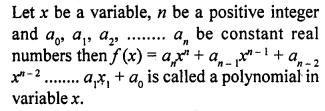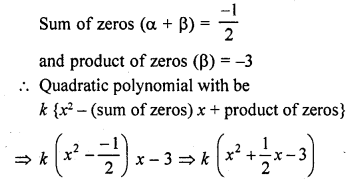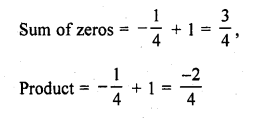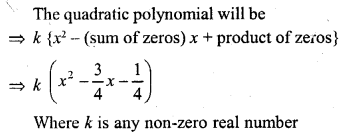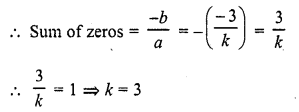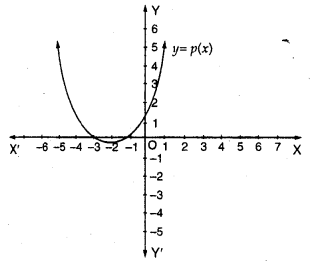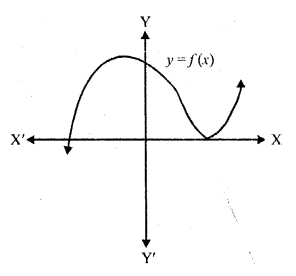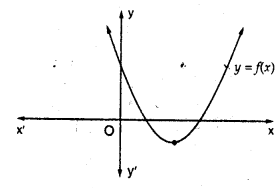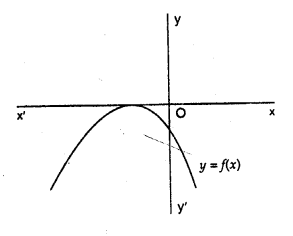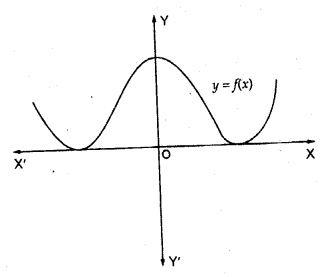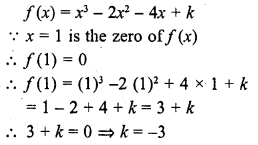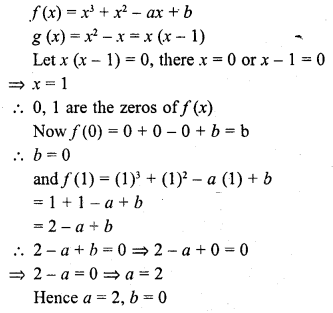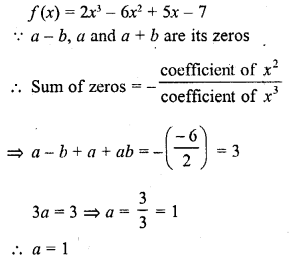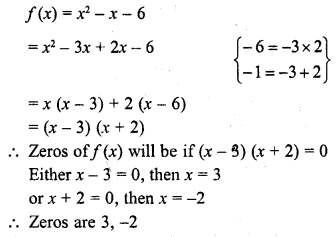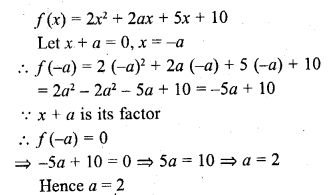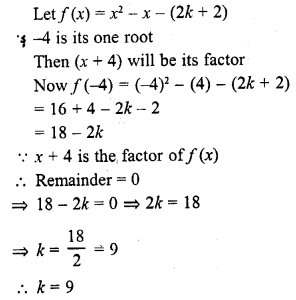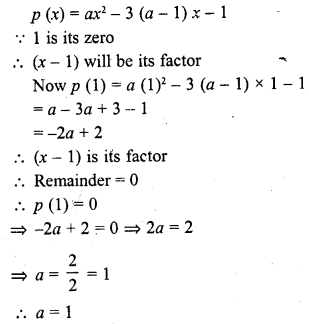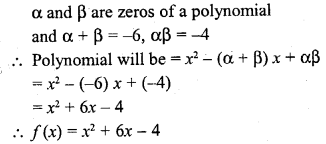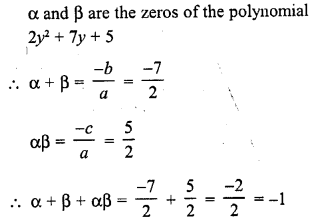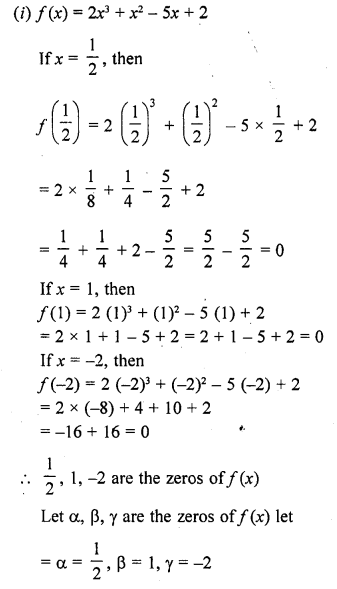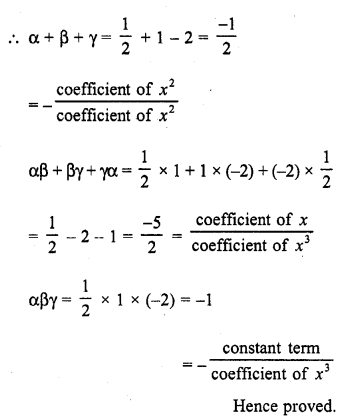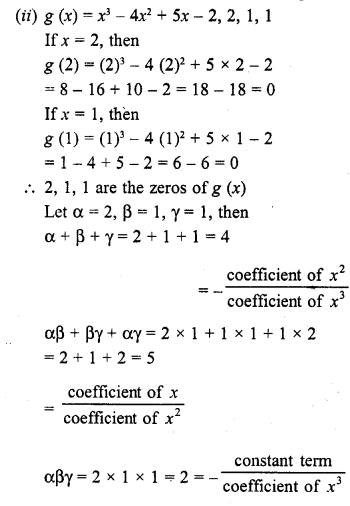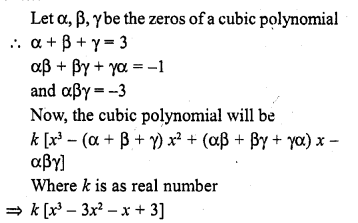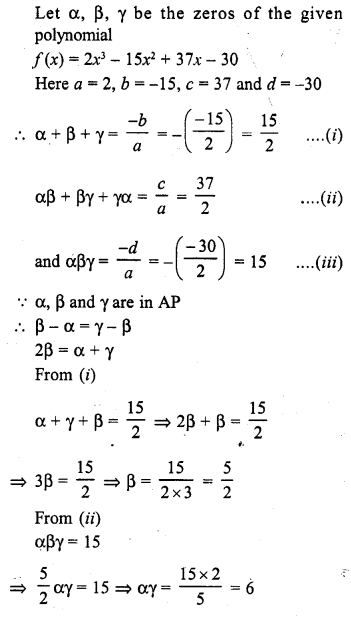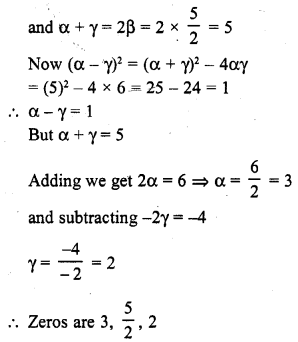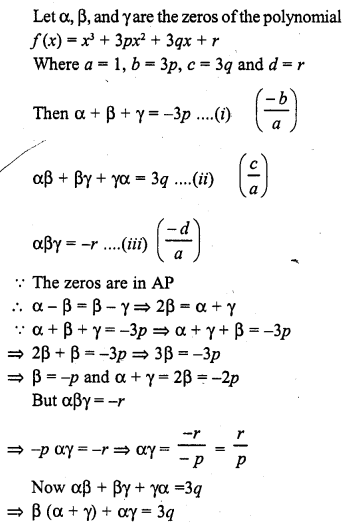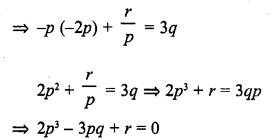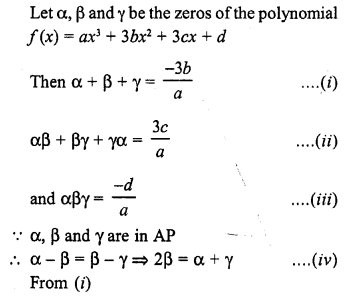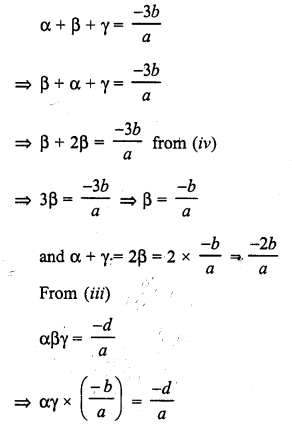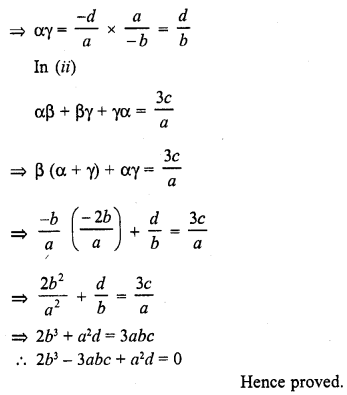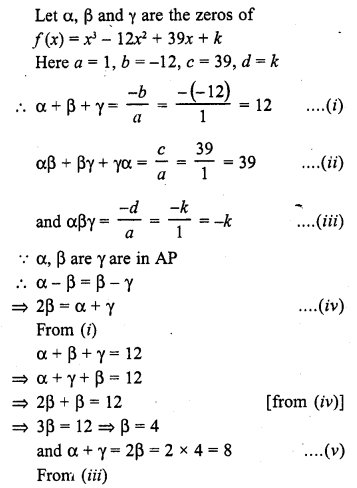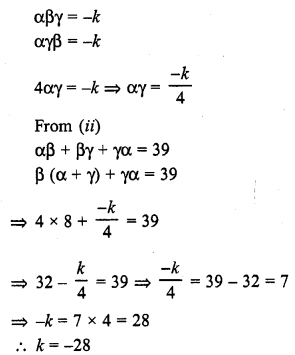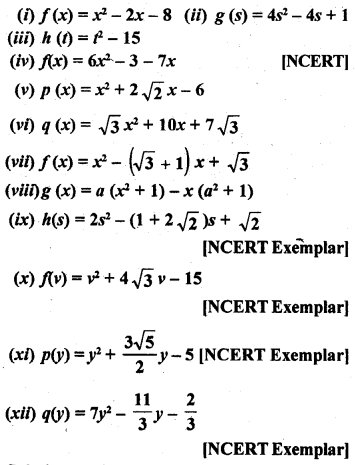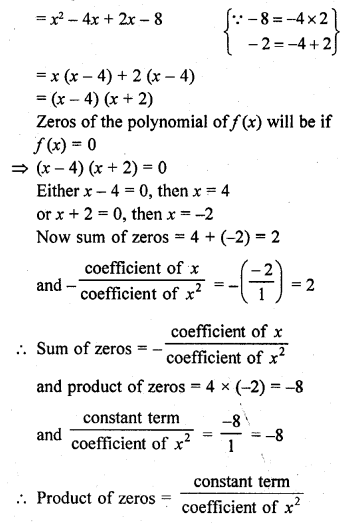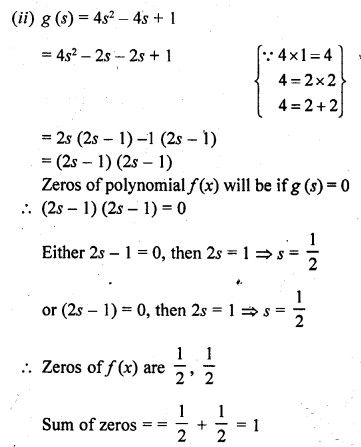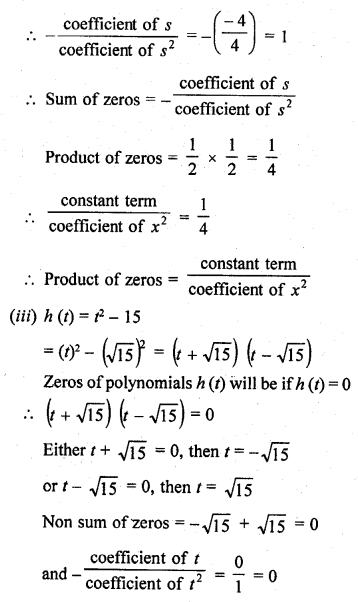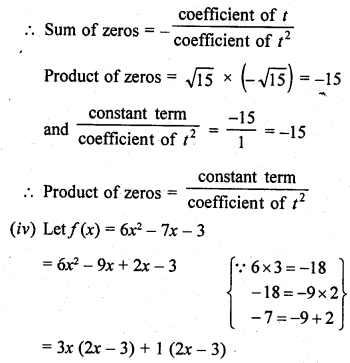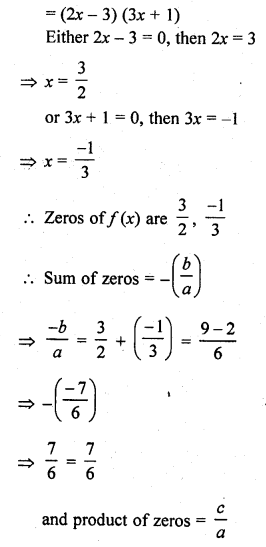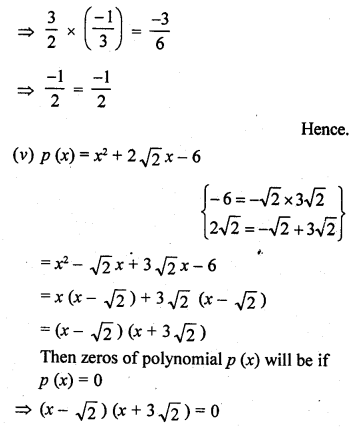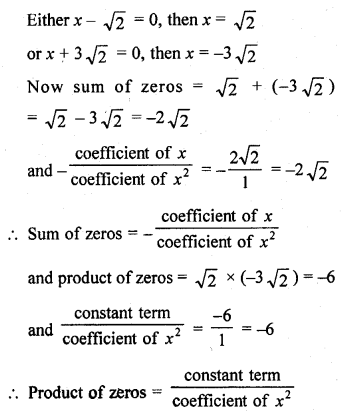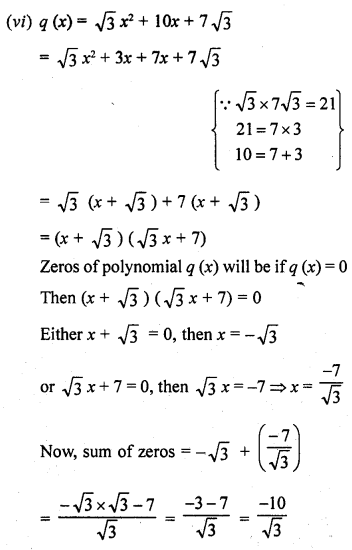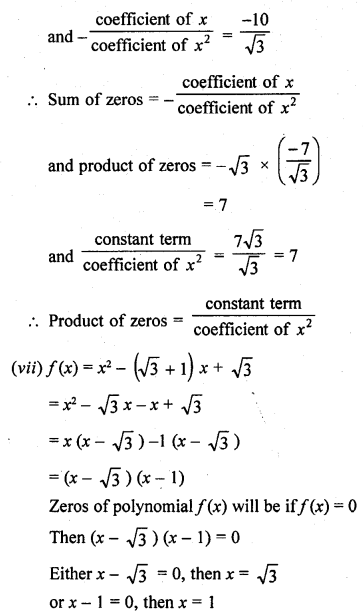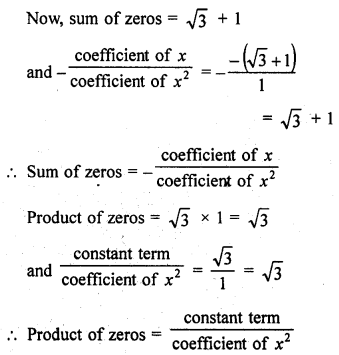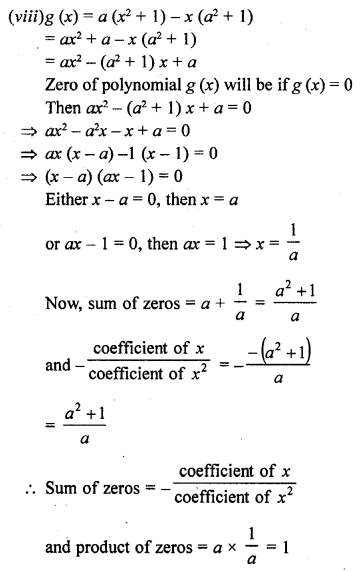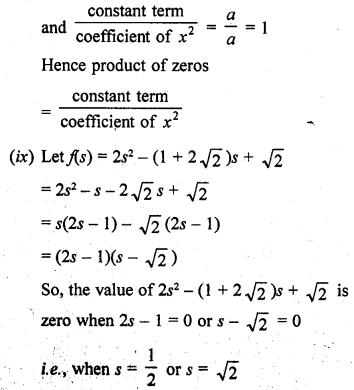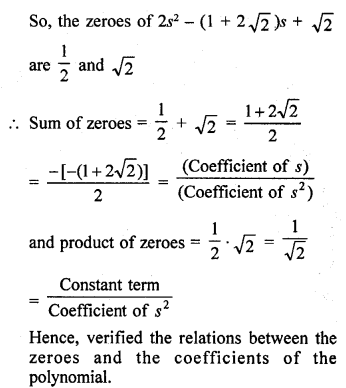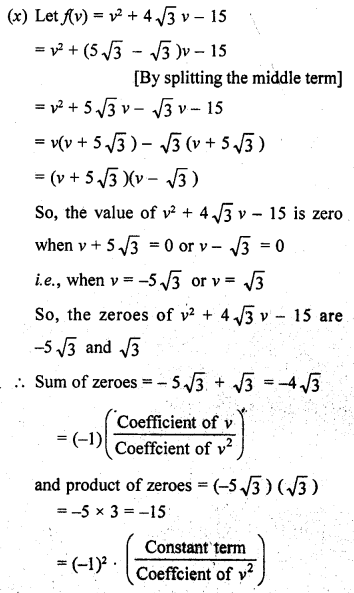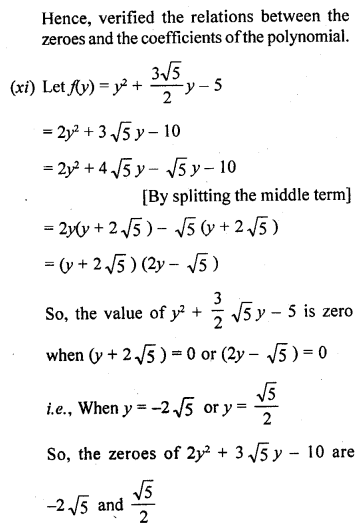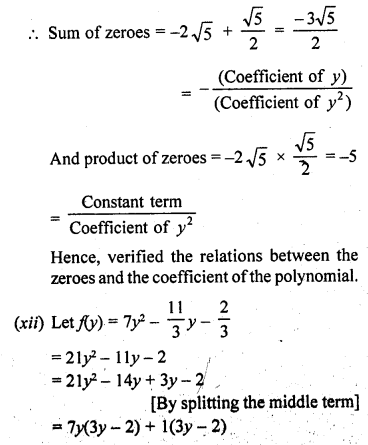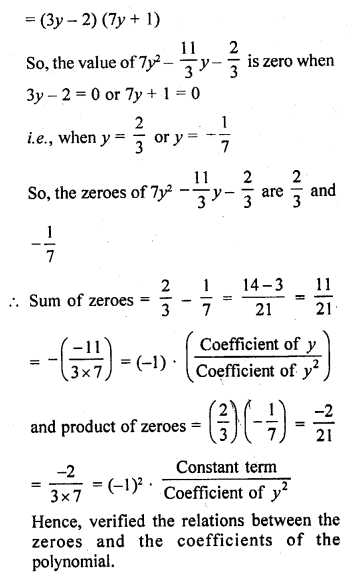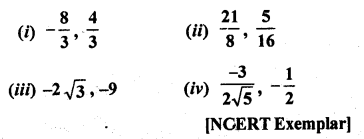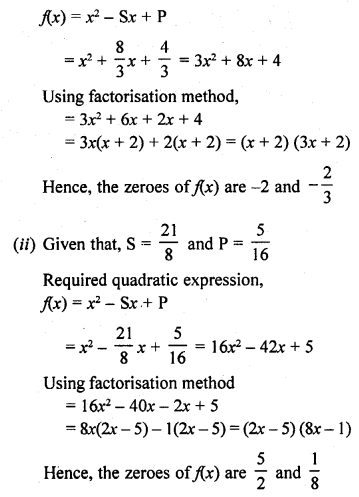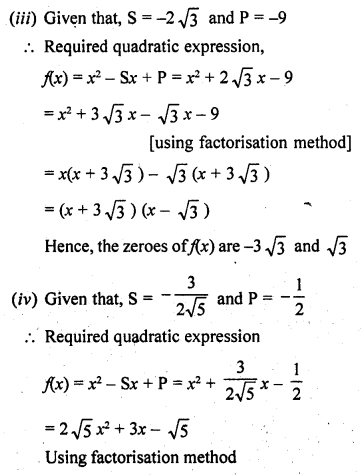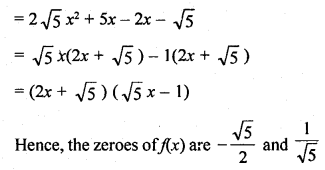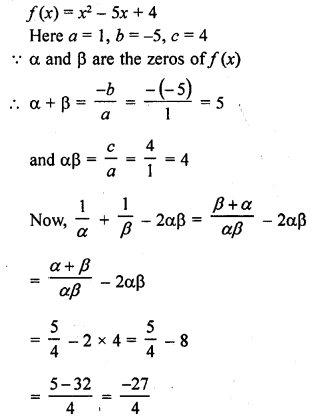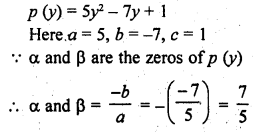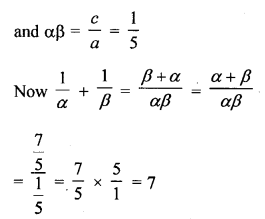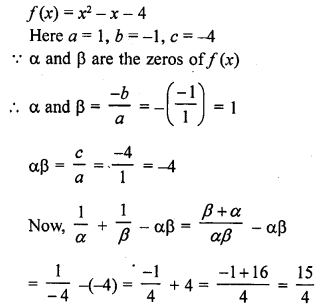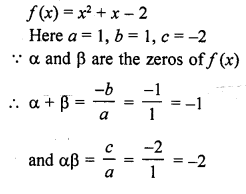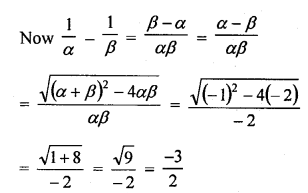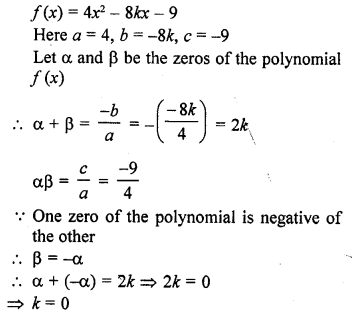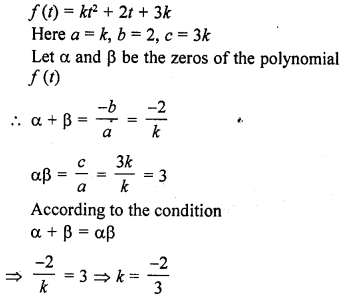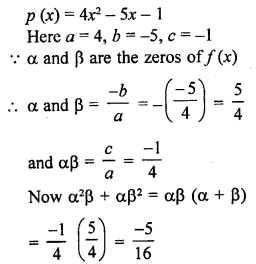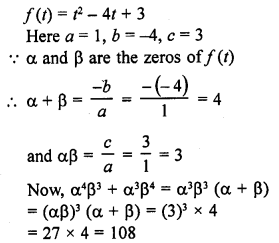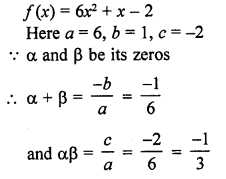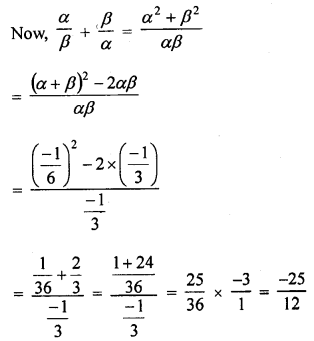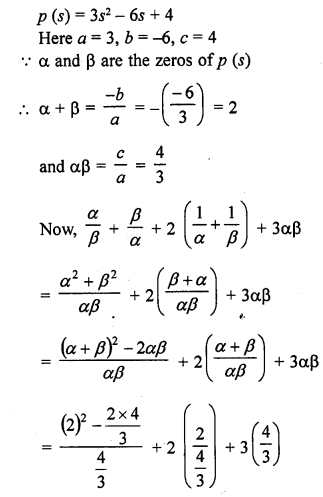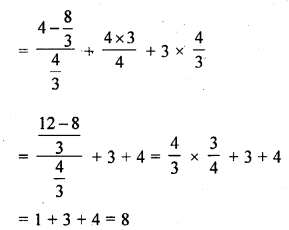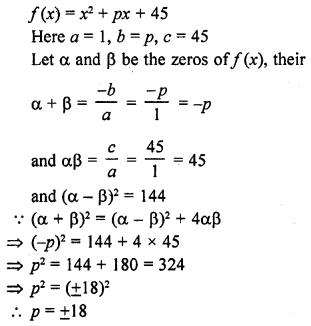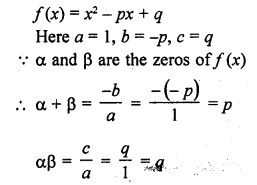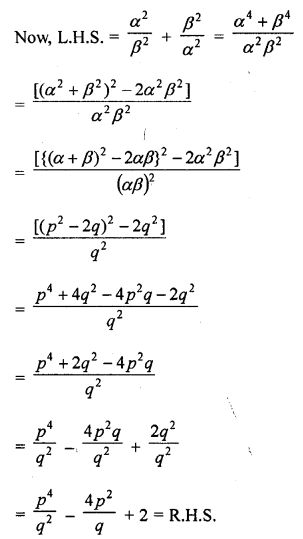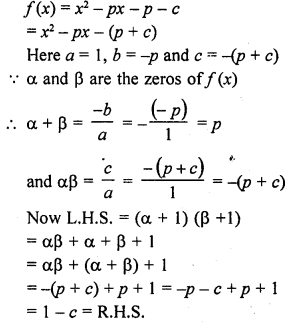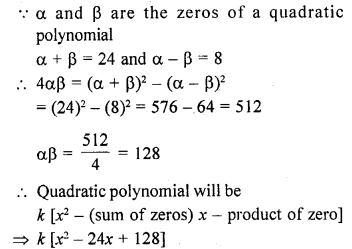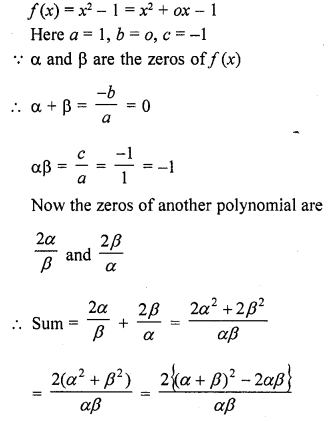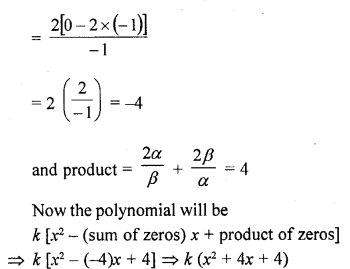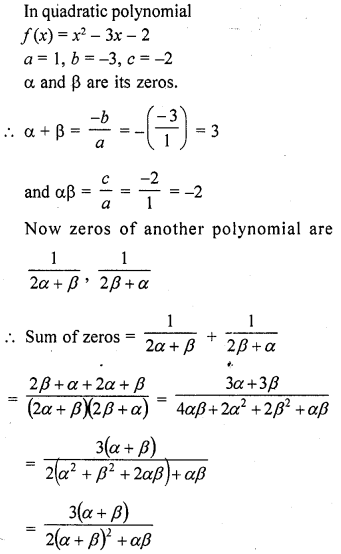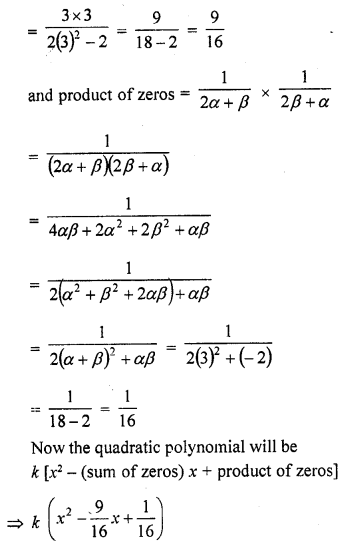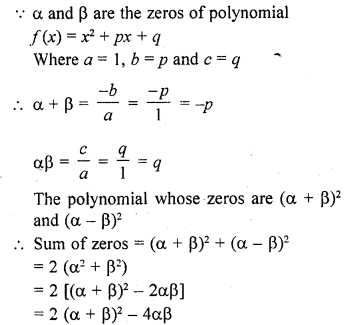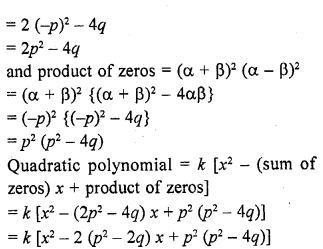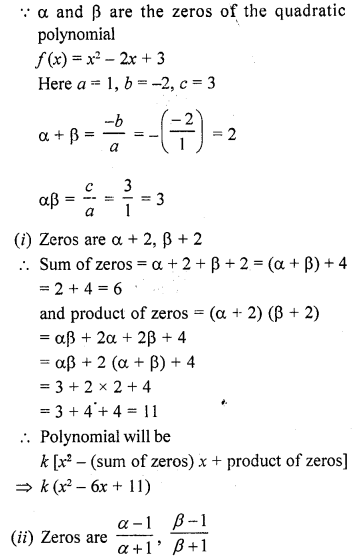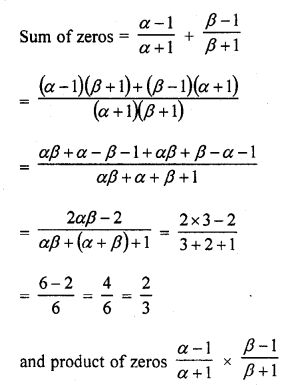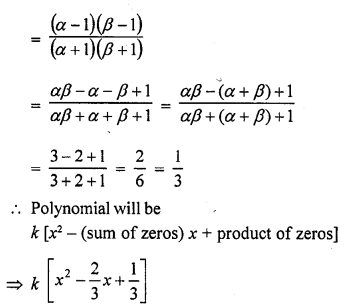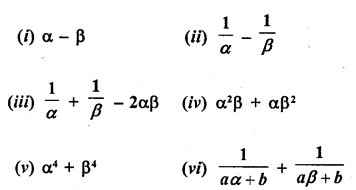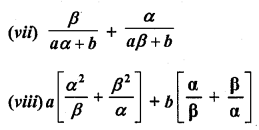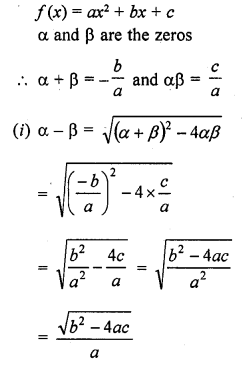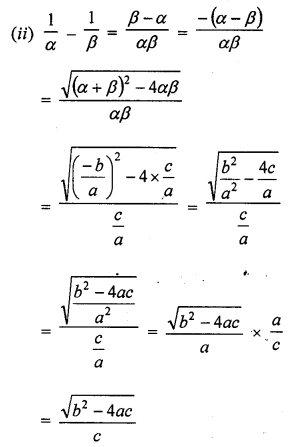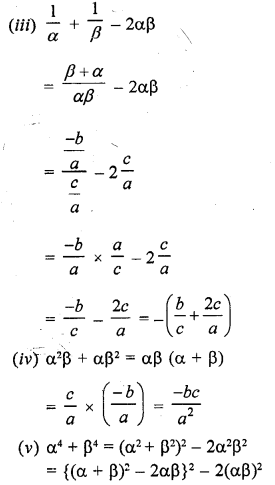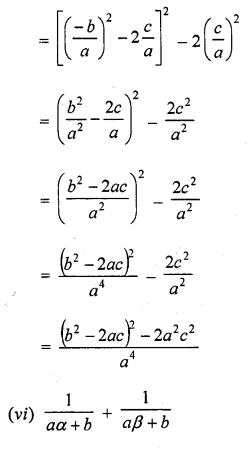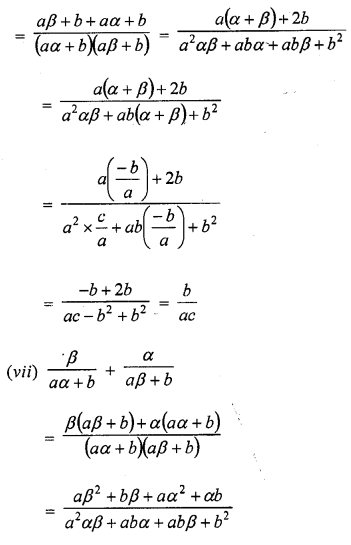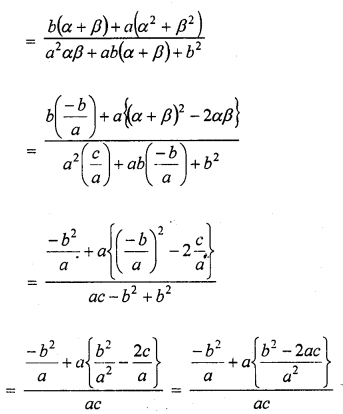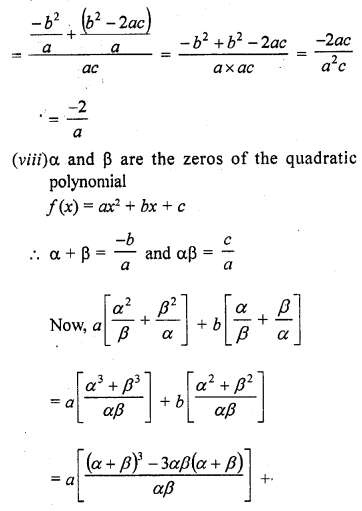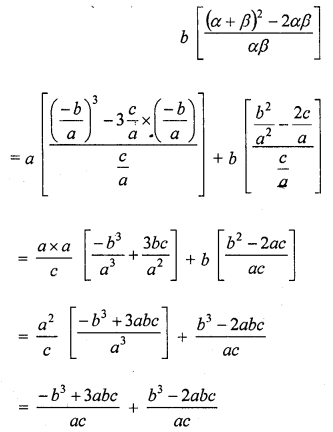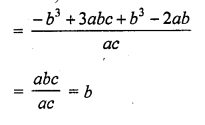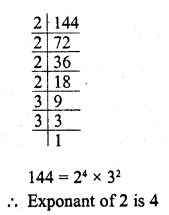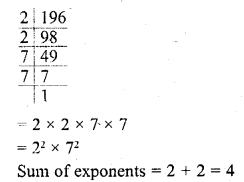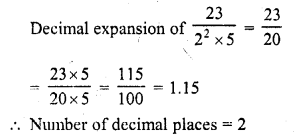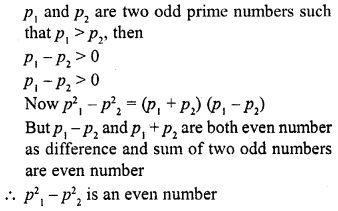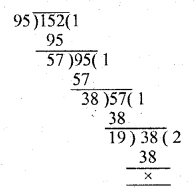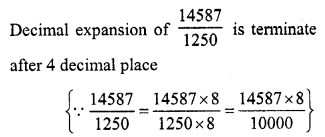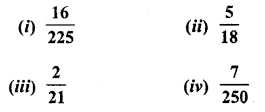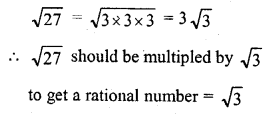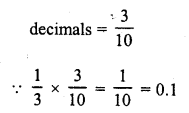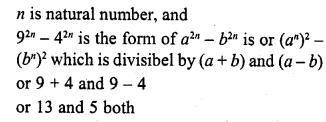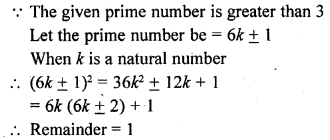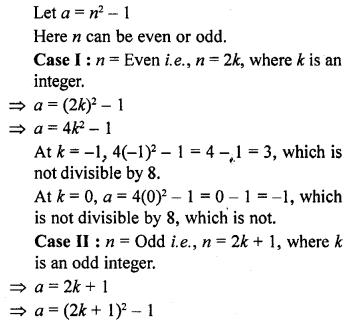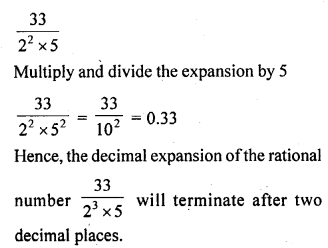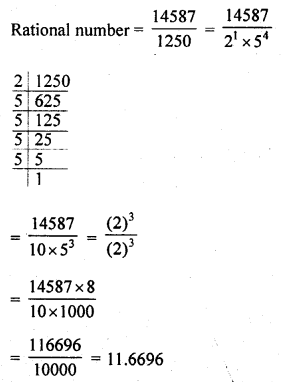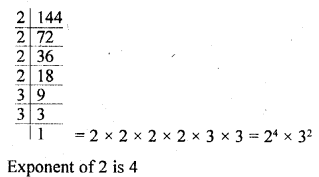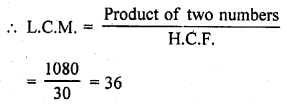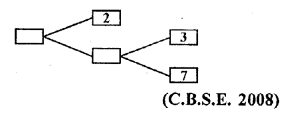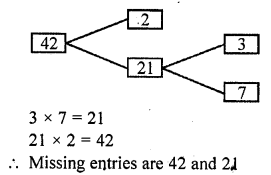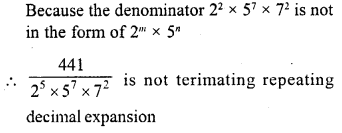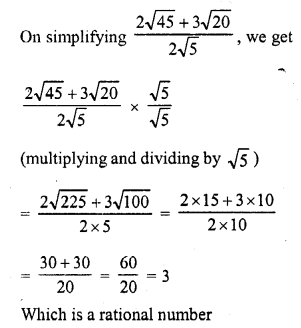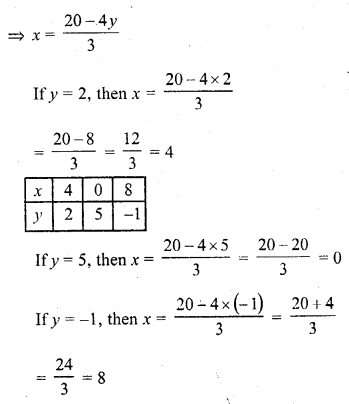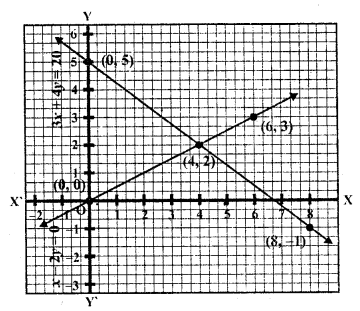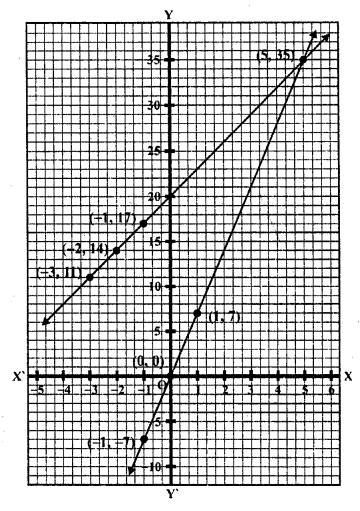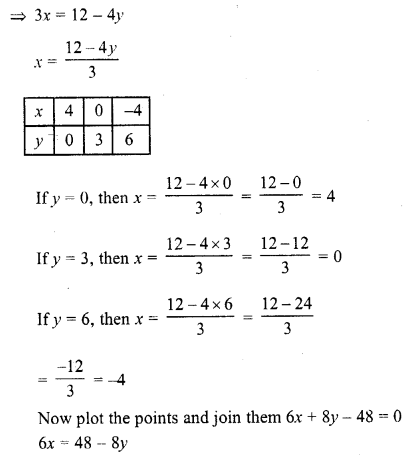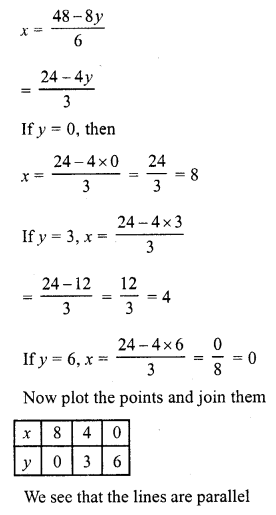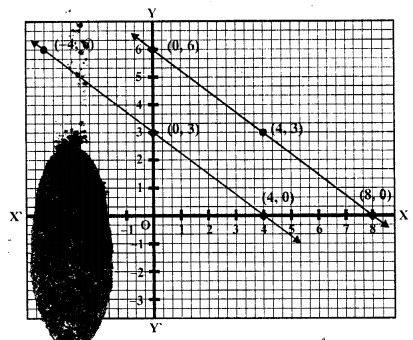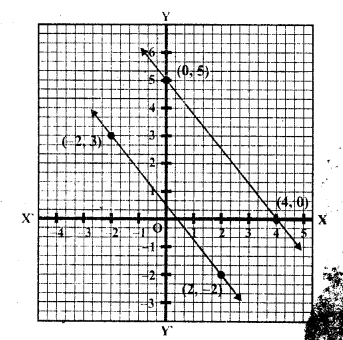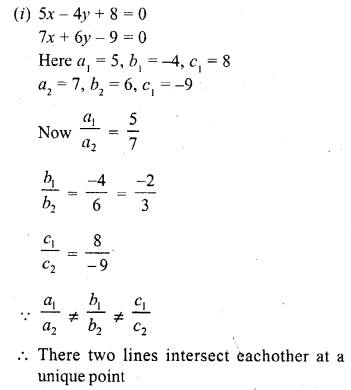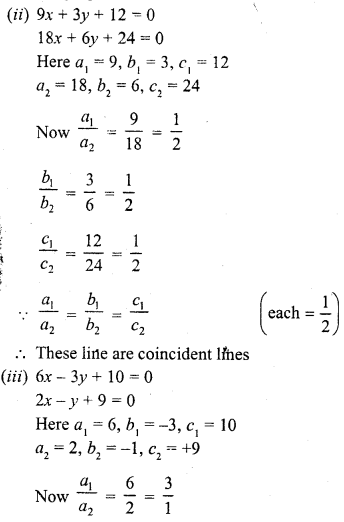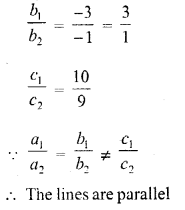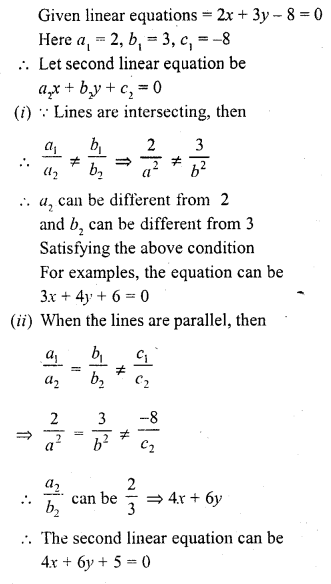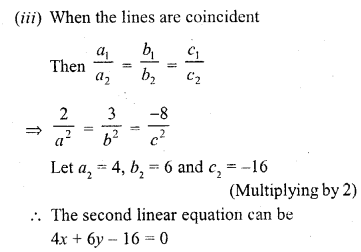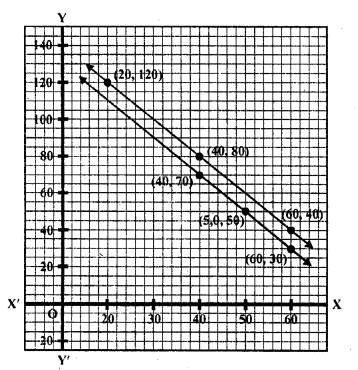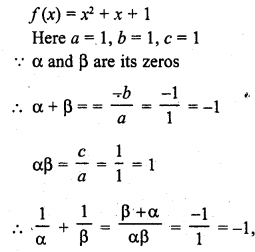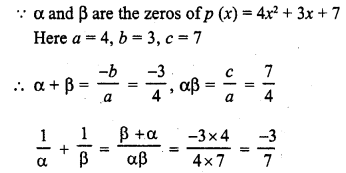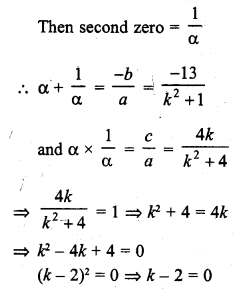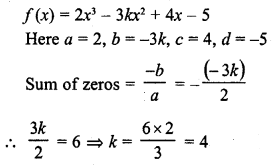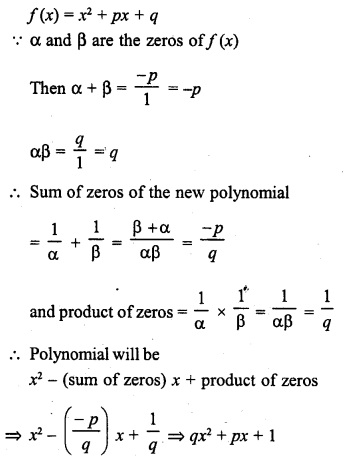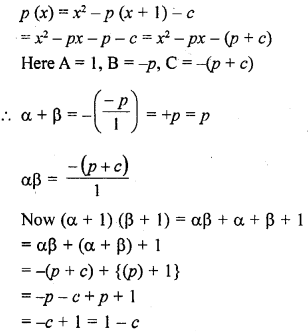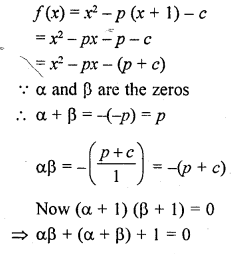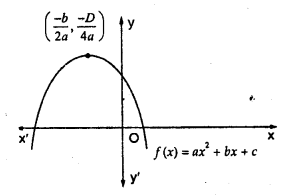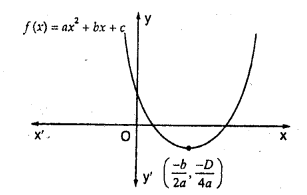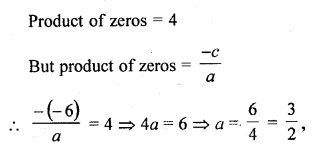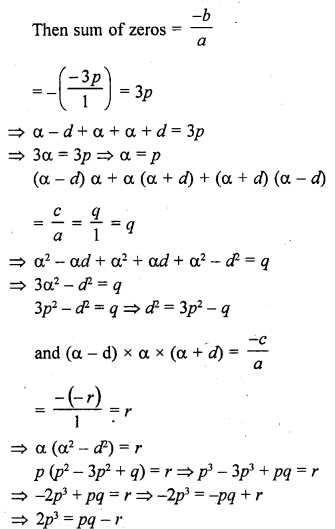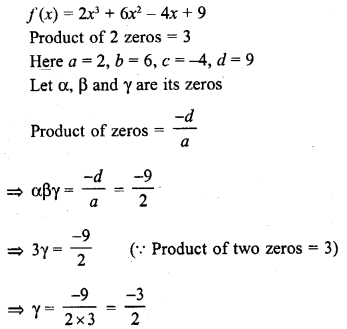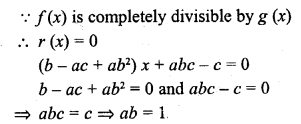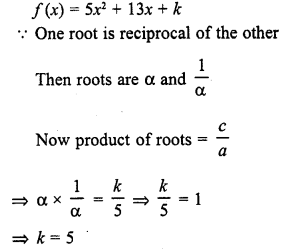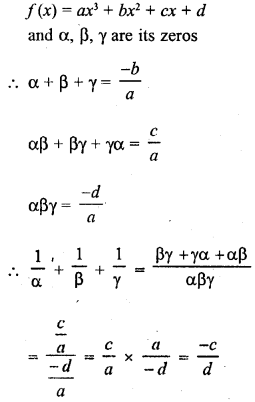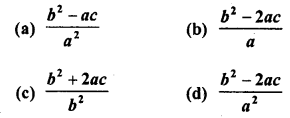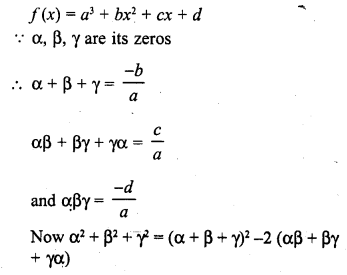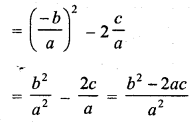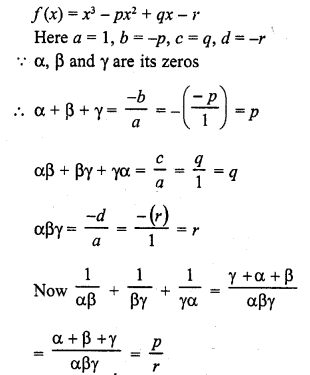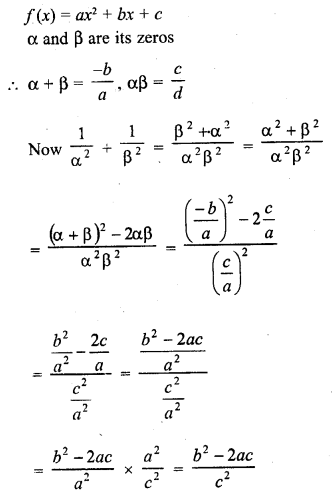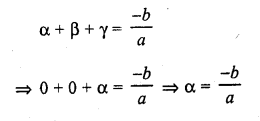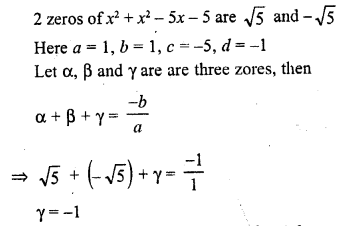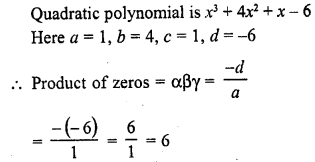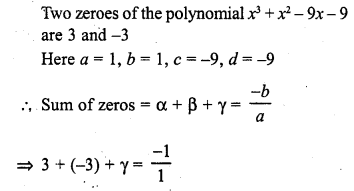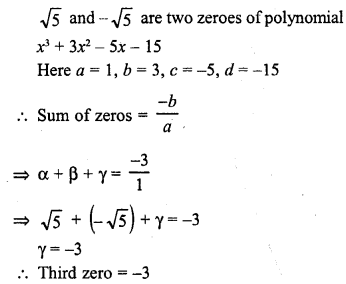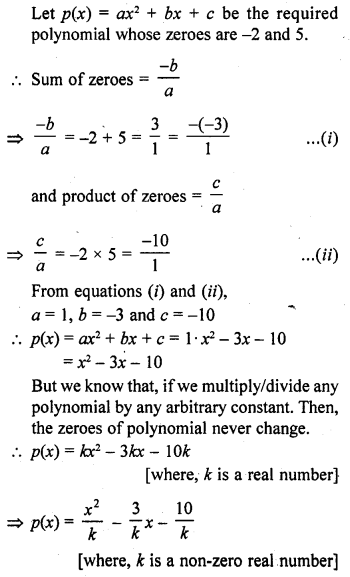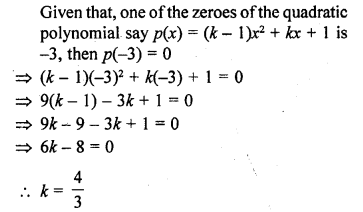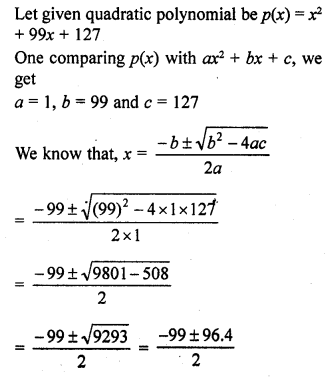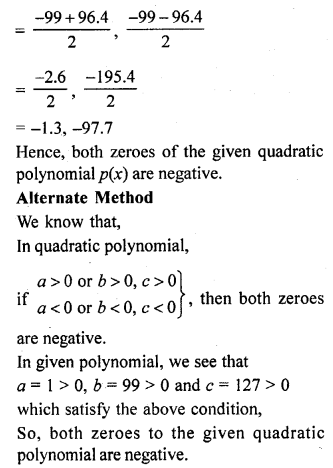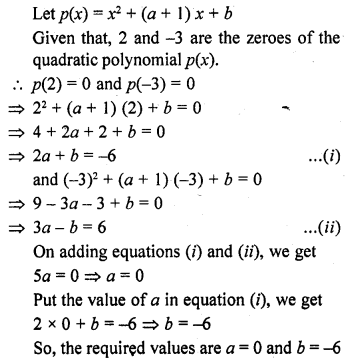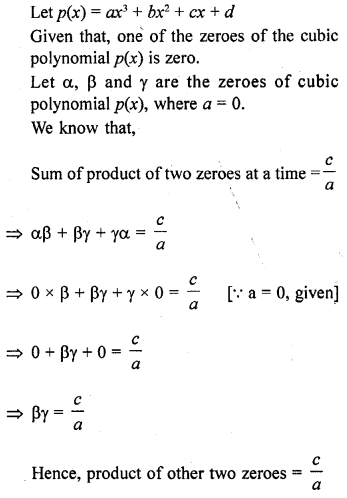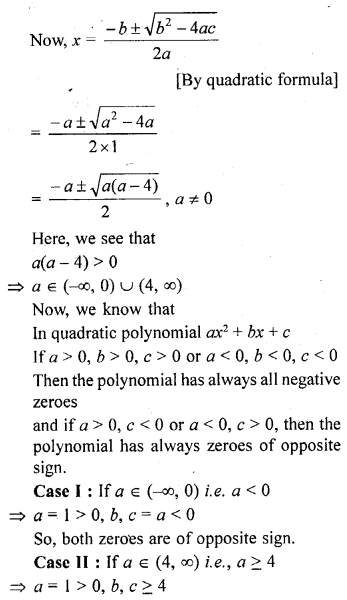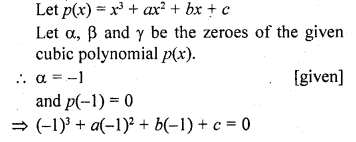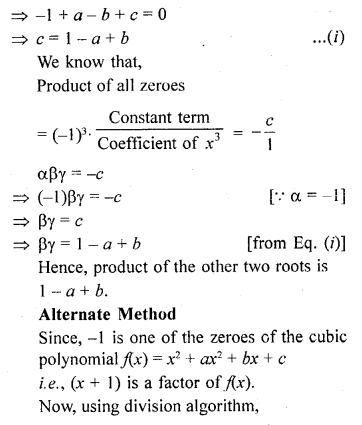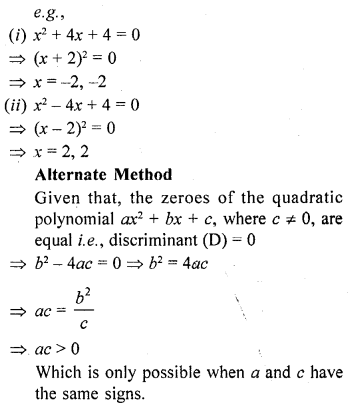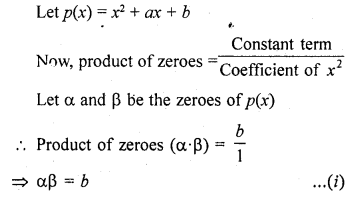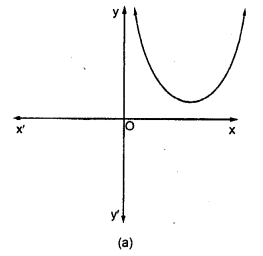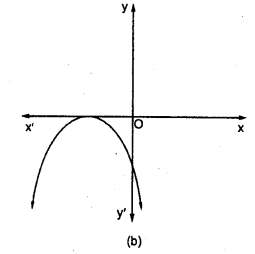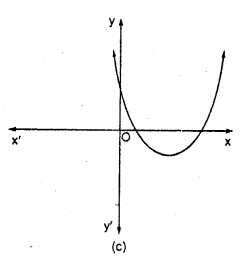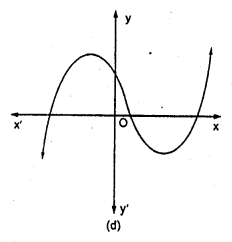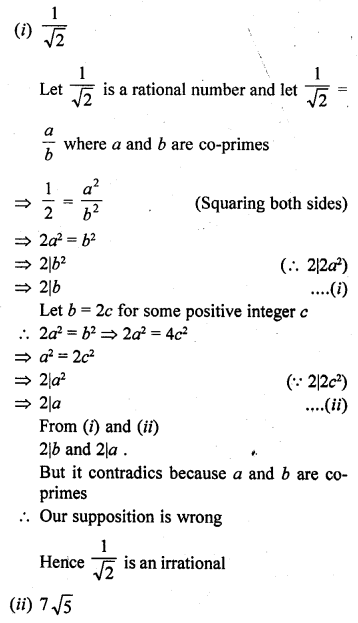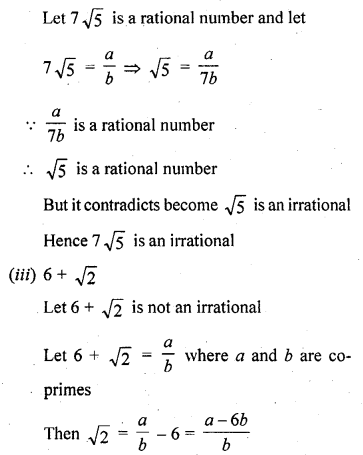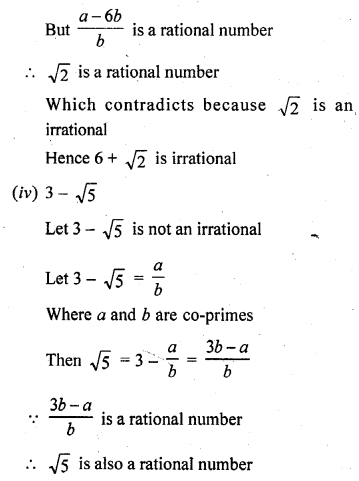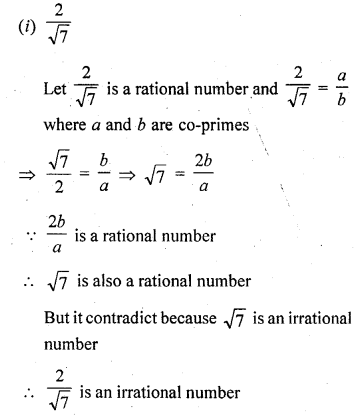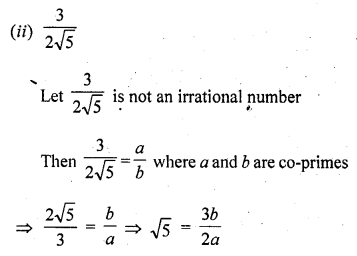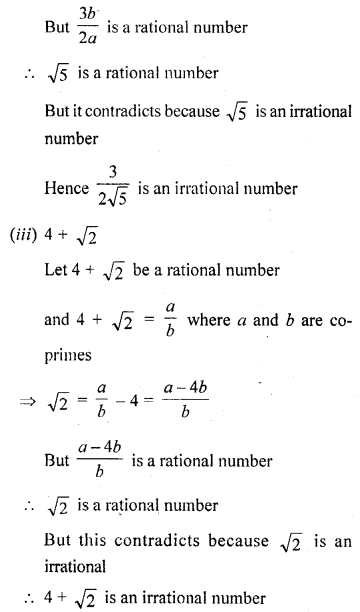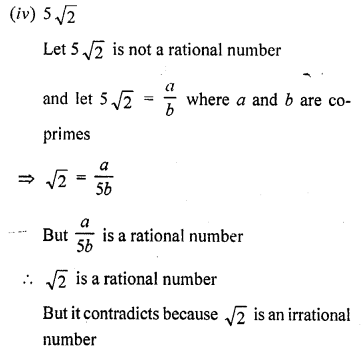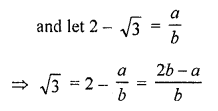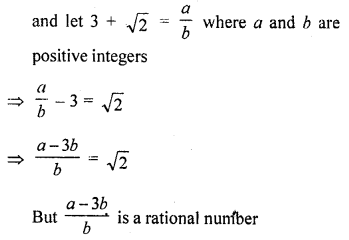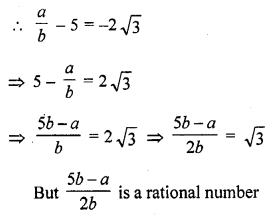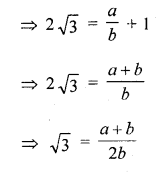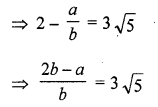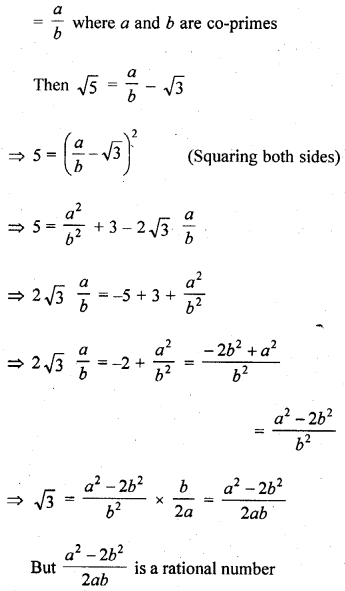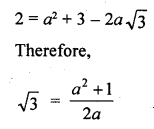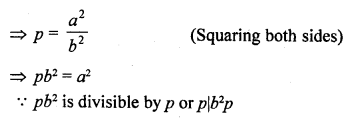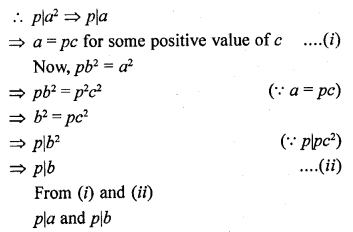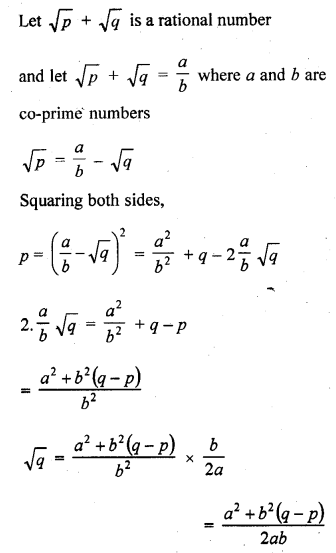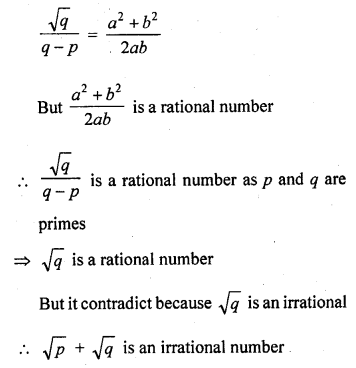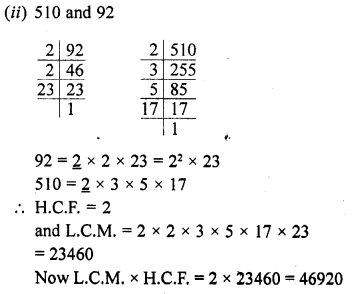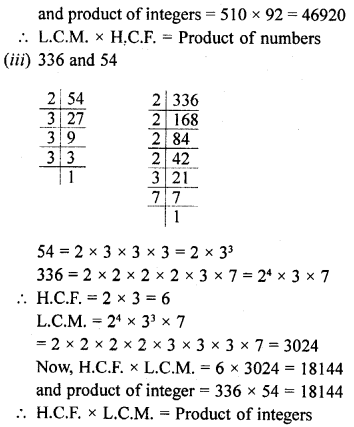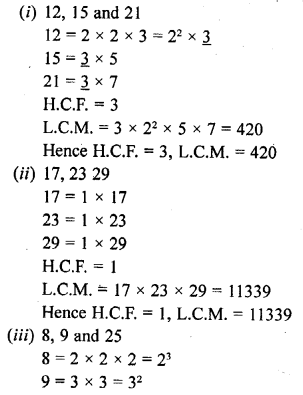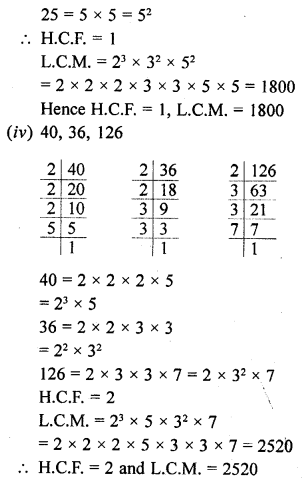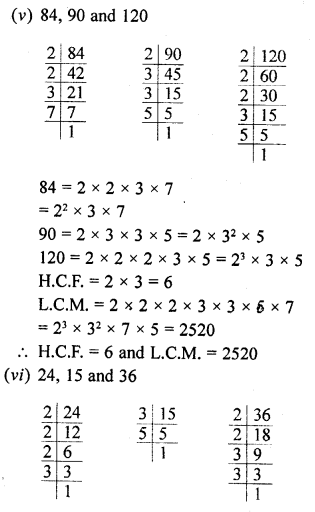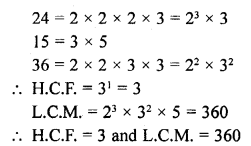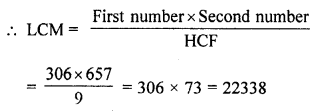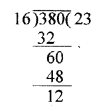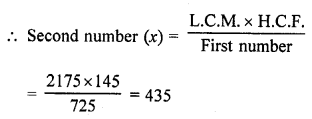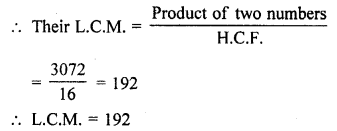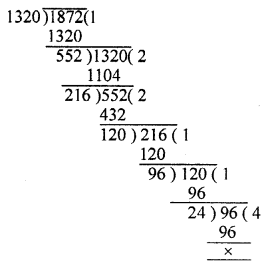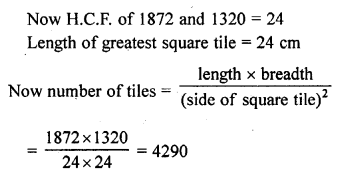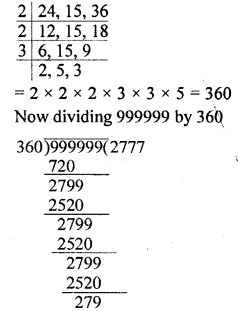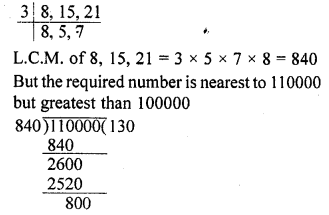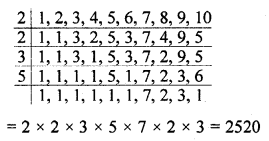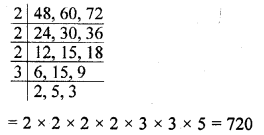RD Sharma Class 10 Solutions Chapter 3 Pair of Linear Equations in Two Variables Ex 3.2
These Solutions are part of RD Sharma Class 10 Solutions. Here we have given RD Sharma Class 10 Solutions Chapter 3 Pair of Linear Equations in Two Variables Ex 3.2
Other Exercises
- RD Sharma Class 10 Solutions Chapter 3 Pair of Linear Equations in Two Variables Ex 3.1
- RD Sharma Class 10 Solutions Chapter 3 Pair of Linear Equations in Two Variables Ex 3.2
- RD Sharma Class 10 Solutions Chapter 3 Pair of Linear Equations in Two Variables Ex 3.3
- RD Sharma Class 10 Solutions Chapter 3 Pair of Linear Equations in Two Variables Ex 3.4
- RD Sharma Class 10 Solutions Chapter 3 Pair of Linear Equations in Two Variables Ex 3.5
- RD Sharma Class 10 Solutions Chapter 3 Pair of Linear Equations in Two Variables Ex 3.6
- RD Sharma Class 10 Solutions Chapter 3 Pair of Linear Equations in Two Variables Ex 3.7
- RD Sharma Class 10 Solutions Chapter 3 Pair of Linear Equations in Two Variables Ex 3.8
- RD Sharma Class 10 Solutions Chapter 3 Pair of Linear Equations in Two Variables Ex 3.9
- RD Sharma Class 10 Solutions Chapter 3 Pair of Linear Equations in Two Variables Ex 3.10
- RD Sharma Class 10 Solutions Chapter 3 Pair of Linear Equations in Two Variables Ex 3.11
- RD Sharma Class 10 Solutions Chapter 3 Pair of Linear Equations in Two Variables VSAQS
- RD Sharma Class 10 Solutions Chapter 3 Pair of Linear Equations in Two Variables MCQS
Solve the following systems of equations graphically :
Question 1.
x + y = 3
2x + 5y = 12 (C.B.S.E. 1997)
Solution:
x + y = 3
=> x = 3 – y
Substituting some different values of y, we get the corresponding values of x as shown below

Now plot the points on the graph and join them 2x + 5y = 12
2x = 12 – 5y
⇒ x = \(\frac { 12-5y }{ 2 }\)
Substituting some different values of y, we get the corresponding values of x as shown below

Now plot the points on the graph and join them we see that these two lines intersect each other at (1, 2)
x = 1, y = 2
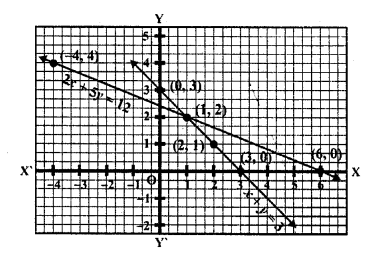
Question 2.
x – 2y = 5
2x + 3y = 10 (C.B.S.E. 1997)
Solution:
x – 2y = 5 => x = 5 + 2y
Substituting some different values of y, we get the corresponding values of x as shown below

Now plot the points are the graph and join them
2x + 3y = 10 => 2x = 10 – 3y
⇒ x = \(\frac { 10-3y }{ 2 }\)
Substituting some different values of y We get the corresponding values of x as shown below :

Now plot the points on the graph and join them we see that these two lines intersect each other at (5, 0)
x = 5, y = 0
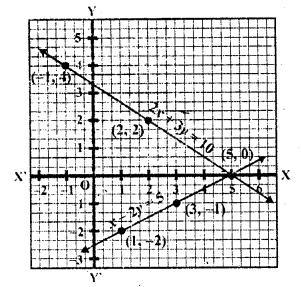
Question 3.
3x + y + 1 = 0
2x – 3y + 8 = 0 (C.B.S.E. 1996)
Solution:
3x + y + 1 = 0
y = -3x – 1
Substituting the values of x, we get the corresponding values of y, as shown below

Now plot the points on the graph and join them
2x – 3y + 8 = 0
⇒ 2x = 3y – 8
⇒ x = \(\frac { 3y-8 }{ 2 }\)
Substituting some different values of y, we get the corresponding values of x as shown below

Now plot the points on the graph and join then we see that these two lines intersect, each other at (-1, -2)
x = -1, y = 2
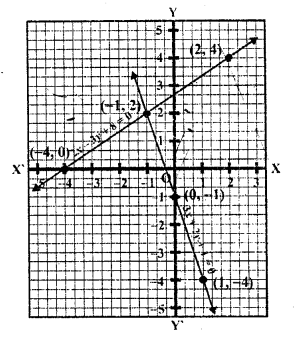
Question 4.
2x + y – 3 = 0
2x – 3y – 7 = 0 (C.B.S.E. 1996)
Solution:
2x + y – 3 = 0 => y = -2x + 3
Substituting some different values of x, we get the corresponding values of y as shown below:

Now plot the points and join them 2x – 3y – 7 = 0
2x = 3y +7
x = \(\frac { 3y+7 }{ 2 }\)
Substituting some different values of y, we get corresponding values of x as shown below:

Now plot the points on the graph and join them we see that these two lines intersect each other at (2, -1)
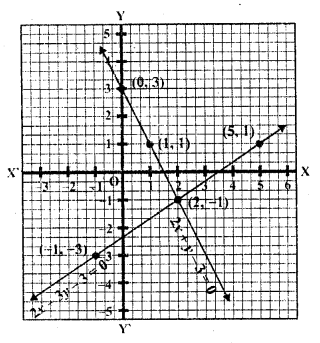
Question 5.
x + y = 6
x – y = 2 (C.B.S.E. 1994)
Solution:
x + y = 6 => x = 6 – y
Substituting some different values of y, we get the corresponding values of x as shown under

Now plot the points on the graph and join them
x – y = 2 ⇒ x = 2 + y
Substituting some different values of y, we get the corresponding values of x as shown below:

Now plot the points on the graph and join them
We see that there two lines intersect each other at (4, 2)
x = 4, y = 2
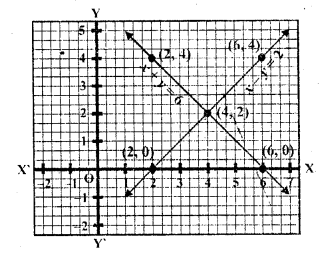
Question 6.
x – 2y = 6
3x – 6y = 0 (C.B.S.E. 1995)
Solution:
x – 2y = 6
x = 6 + 2 y
Substituting some different values ofy, we get the corresponding values of x as shown below:

Now plot the points and join them
3x – 6y = 0 ⇒ 3x = 6y ⇒ x = 2y
Substituting some different value of y, we get corresponding the values of x as shown below:

plot the points on the graph and join them We see that these two lines intersect each other at no point
The lines are parallel
There is no solution
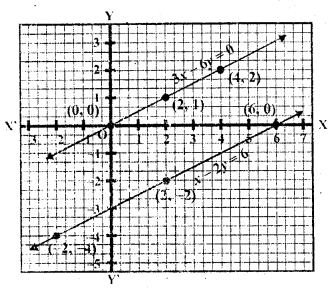
Question 7.
x + y = 4
2x – 3y = 3 (C.B.S.E. 1995)
Solution:
x + y = 4 => y = 4 – x
Substituting some different values of y, we get the corresponding values of x as shown below:

Now plot the points and join them 2x – 3y = 3
⇒ 2x = 3 + 3y
⇒ x = \(\frac { 3+3y }{ 2 }\)
Substituting some different values of y, we get the corresponding values of x as shown below:

Now plot the points on the graph and join them we see that these two lines intersect each other at (3, 1)
x = 3, y = 1
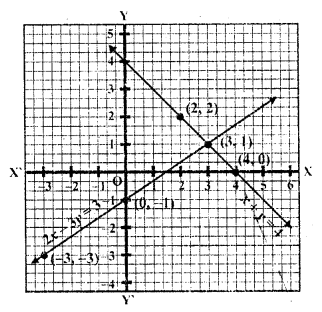
Question 8.
2x + 3y= 4
x – y + 3 = 0 (C.B.S.E. 1995)
Solution:
2x + 3y = 4
=> 2x = 4 – 3y
=> x = \(\frac { 4-3y }{ 2 }\)
Substituting some different values of y, we get corresponding values of x as shown below:

Now plot the points are the graph and join them
x – y + 3 = 0
x = y – 3
Substituting some different values of y, we get corresponding values of x as shown below:

Now plot the points on the graph and join them
We see that these two lines intersect each other at (-1, 2)
x = -1, y = 2
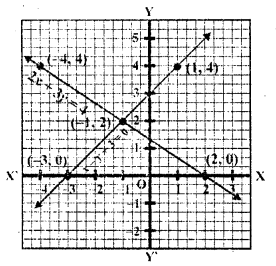
Question 9.
2x – 3y + 13 =0
3x – 2y + 12 = 0 (C.B.S.E. 2001C)
Solution:
2x – 3y + 13 = 0
2x = 3y – 13
=> x = \(\frac { 3y – 13 }{ 2 }\)
Substituting some different values of y, we get corresponding values of x as shown below

Plot the points on the graph and join them 3x – 2y + 12 = 0
3x = 2y – 12
x = \(\frac { 2y – 12 }{ 3 }\)
Substituting some different values of y, we get corresponding values of x as shown below

Plot the points and join them We see that these two lines intersect each other at (-2, 3)
x = -2, y = 3
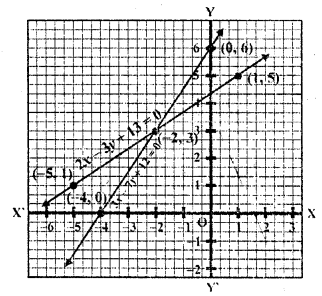
Question 10.
2x + 3y + 5 = 0
3x – 2y – 12 = 0 (C.B.S.E. 2001 C)
Solution:
2x + 3y + 5 = 0
2x = – 3y – 5
x = \(\frac { – 3y – 5 }{ 2 }\)
Substituting some different value of y, we get corresponding values of x as shown below

Now plot the points on the graph and join them
3x – 2y – 12 = 0
3x = 2y +12
x = \(\frac { 2y +12 }{ 3 }\)
Substituting some different value of y, we get corresponding values of x as shown below:

Now plot the points on the graph and join them we see that these lines intersect each other at (2, -3)
x = 2, y = -3
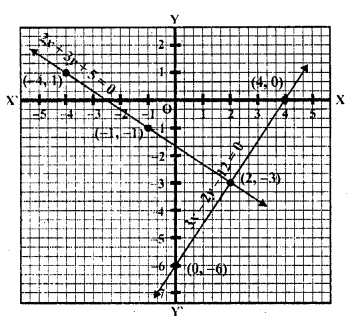
Show graphically that each one of the following systems of equations has infinitely many solutions :
Question 11.
2x + 3y = 6
4x + 6y = 12 [CBSE2010]
Solution:
2x + 3y = 6 ……….(i)
4x + 6y = 12 ……….(ii)
2x = 6 – 3y
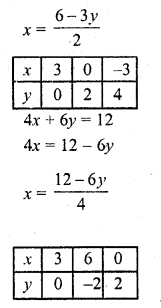
Now plot the points of both lines on the graph and join them, we see that all the points lie on the same straight line
This system has infinitely many solutions
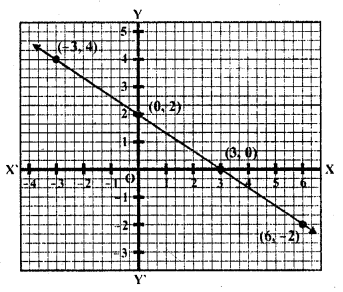
Question 12.
x – 2y = 5
3x – 6y = 15
Solution:
x – 2y = 5
x = 5 + 2y
Substituting some different values of y, we get corresponding values of x as shown below:

Now plot these points on the graph and join them
3x – 6y = 15
=> 3x = 15 + 6y
x = \(\frac { 15 + 6y }{ 3 }\)
Substituting some different values of y, we get corresponding values of x as shown below:

Now plot there points on the graph and join then
We see that these two lines coincide each other
This system has infinitely many solutions.
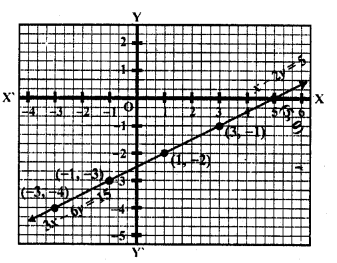
Question 13.
3x +y = 8
6x + 2y = 16
Solution:
3x + y = 8 => y = 8 – 3x
Substituting some different values of x, we get corresponding values of y as shown below:

Now plot these points on the graph and join them
6x + 2y – 16 => 6x = 16 – 2y
x = \(\frac { 16 – 2y }{ 6 }\)
x = \(\frac { 8 – y }{ 3 }\) (Dividing by 2)
Substituting some different values of y, we get their corresponding values of x as shown below:

Now plot the points and point them
We see that the two lines coincide each other
This system has infinitely many solutions
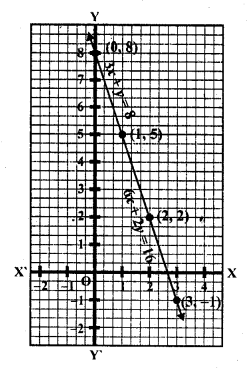
Question 14.
x- 2y + 11 = 0
3x – 6y + 33 = 0
Solution:
x – 2y + 11 = 0
x = 2y – 11
Substituting some different values of y, we get their corresponding values of x as shown below

Plot the points on the graph and join them 3x – 6y + 33 = 0
3x = 6y – 33
x = \(\frac { 6y – 33 }{ 3 }\)
Substituting some different values of y, we get corresponding values of x as shown below

Plot the points on the graph and join them we see that the two lines coincide each other
This system has infinitely many solutions.
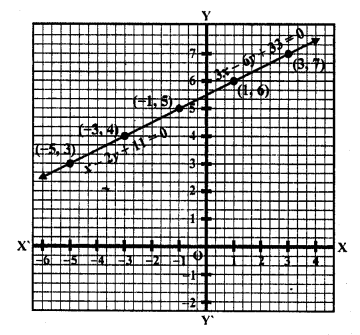
Show graphically that each one of the following systems of equations is inconsistent (i.e., has no solution)
Question 15.
3x – 5y = 20
6x – 10y = -40 (C.B.S.E. 1995C)
Solution:
3x – 5y = 20
3x = 20 + 5y
x = \(\frac { 20 + 5y }{ 3 }\)
Substituting some different values of y, we get their corresponding values of x as shown below

Plot the points on the graph and join them
6x – 10y = -40
6x = 10y – 40
x = \(\frac { 10y – 40 }{ 6 }\)
Substituting some different values of y, we get their corresponding values of x as shown below

Plot the points on the graph and join them we see that the lines are parallel
The given system of equations is inconsistant and has no solution.
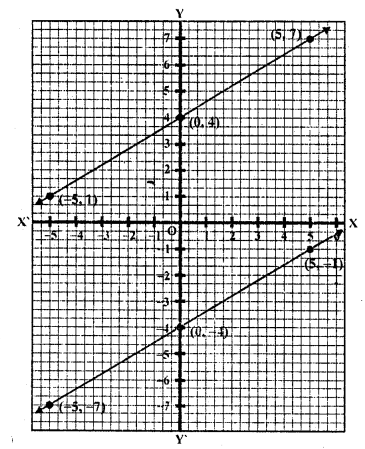
Question 16.
x – 2y = 6
3x – 6y = 0 (C.B.S.E. 1995)
Solution:
x – 2y = 6
x = 6 + 2y
Substituting some different values of y, we get their corresponding values of x as shown below:

Plot the points on the graph and join them
3x – 6y = 0
=> 3x = 6y
=> x = 2y
Substituting some different values of y, we get their corresponding values of x as shown below:

Plot the points on the graph and join them We see that the lines are parallel
The system of equation is inconsistant and therefore has no solution.
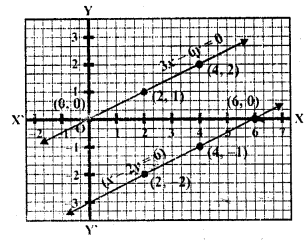
Question 17.
2y – x = 9
6y – 3x = 21 (C.B.S.E. 1995C)
Solution:
2y – x = 9
=> x = 2y – 9
Substituting some different values of y, we get their corresponding values of x as shown below:

Now plot the points on the graph and join them
6y – 3x = 21
=> 6y = 21 + 3x
y = \(\frac { 21 + 3x }{ 6 }\)
Substituting some different values of x, we get their corresponding values of y as shown below:

Now plot the points on the graph and join them we see that the lines are parallel
The system of equations is inconsistant and therefore has no solution.
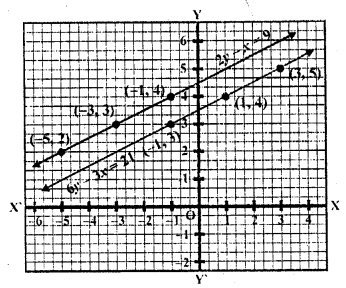
Question 18.
3x – 4y – 1 = 0
2x – \(\frac { 8 }{ 3 }\) y + 5 = 0
Solution:
3x – 4y -1 = 0
3x = 4y + 1
x = \(\frac { 4y + 1 }{ 3 }\)
Substituting some different values of y, we get their corresponding values of x as shown below:

Now plot the points on the graph and join them
2x – \(\frac { 8 }{ 3 }\) y + 5 = 0
=> 6x – 8y + 15 = 0
=> 6x = 8y – 15
=> x = \(\frac { 8y – 15 }{ 6 }\)
Now substituting some different values of y, we get their corresponding values of x as shown below
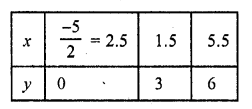
Plot the points on the graph and join them We see that the lines are parallel
The system of equations is inconsistant Therefore has no solution.
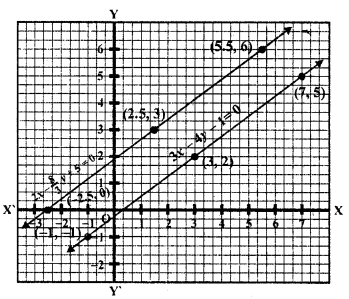
Question 19.
Determine graphically the vertices of the triangle the equations of whose sides are given below :
(i) 2y – x = 8, 5y – x = 14 and y – 2x = 1 (C.B.S.E. 1994)
(ii) y = x, y = 0 and 3x + 3y = 10 (C.B.S.E. 1994)
Solution:
(i) Equations of the sides of a triangle are 2y – x = 8, 5y – x = 14 and y – 2x = 1
2y – x = 8
x = 2y – 8
Substituting some different values of y, we get their corresponding values of x as shown below

Now plot the points and join them Similarly in 5y – x = 14
x = 5y – 14
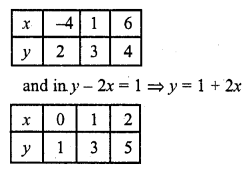
Now plot these points and join them in each case
We see that these lines intersect at (-4, 2), (1, 3) and (2, 5) which are the vertices of the triangle so formed.
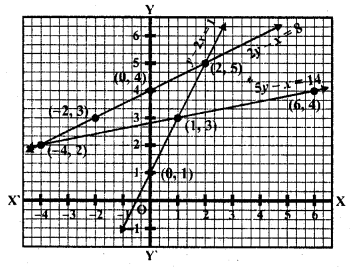
(ii) y = x, y = 0 and 3x + 3y = 10
y = x
Substituting some different values of x, we get their corresponding values of y, as shown below
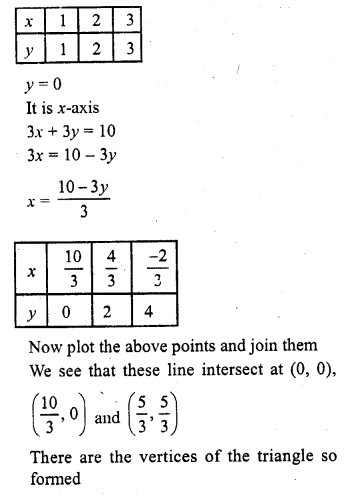
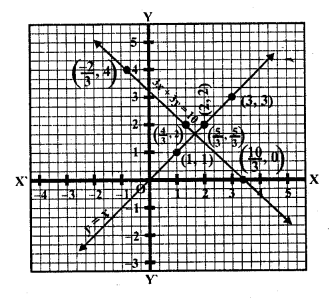
Question 20.
Determine graphically whether the system of equations x – 2y = 2, 4x – 2y = 5 is consistent or in-consistent ?
Solution:
x – 2y = 2
x = 2y + 2
Substituting some values of y, we get their corresponding values of x, as shown below

Now plot the points on the graph and join them
4x – 2y = 5
4x = 2y + 5
x = \(\frac { 2y + 5 }{ 4 }\)
Substituting some different values of y, we get their corresponding values bf x as shown below
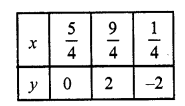
Now plot the above points and join them We see that there two lines intersect each other
The system is consistant
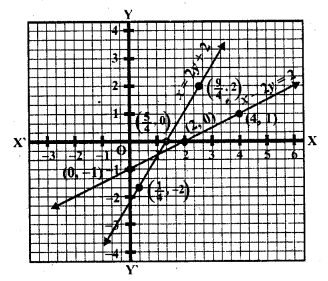
Question 21.
Determine by drawing graphs, whether the following system of linear equations has a unique solution or not :
(i) 2x – 3y = 6, x + y = 1 (C.B.S.E. 1994)
(ii) 2y = 4x – 6, 2x = y + 3 (C.B.S.E. 1995C)
Solution:
(i) 2x – 3y = 6, x + y = 1
2x – 3y = 6
=> 2x = 6 + 3y
=> x = \(\frac { 6 + 3y }{ 2 }\)
Substituting some different values of y, we get their coiTesponding values of x show below

Now plot the points and join them
x + y = 1 => x = 1 – y
Substituting some different of y, we get their corresponding value of x as given below

Now plot the points on the graph and join them we see that the lines intersect at a point
This system has a unique solution.
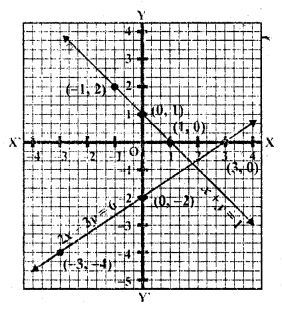
(ii) 2y = 4x – 6, 2x = y + 3
2y = 4x – 6
y = \(\frac{ 4x – 6 }{ 2 }\) = 2x – 3
Substituting some different values of x, we get their corresponding values of y as shown below

Now plot the points on the graph and join them
2x = y + 3
x = \(\frac { y + 3 }{ 2 }\)
Substituting some different values of y, we get their corresponding values of x as shown below

Plot the points on the graph and join them We see the lines coinside each other
This system has no unique solution.
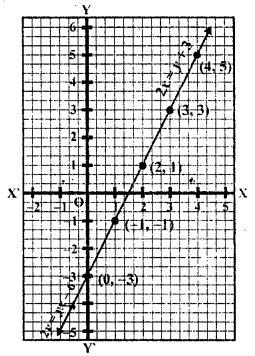
Question 22.
Solve graphically each of the following systems of linear equations. Also And the coordinates of the points where the lines
meet axis of y.
(i) 2x – 5y + 4 = 0
2x + y – 8 = 0 (C.B.S.E. 2005)
(ii) 3x + 2y = 12
5x – 2y = 4 (C.B.S.E. 2000C)
(iii) 2x + y – 11 = 0
x – y – 1=0 (C.B.S.E. 2000C)
(iv) x + 2y – 7 = 0
2x – y – 4 = 0 (C.B.S.E. 2000C)
(v) 3x + y – 5 = 0
2x – y – 5 = 0 (C.B.S.E. 2002C)
(vi) 2x – y – 5 = 0
x – y – 3 = 0 (C.B.S.E. 2002C)
Solution:
(i) 2x – 5y + 4 = 0, 2x – 5y + 4 = 0
2x – 5y + 4 = 0 ⇒ 2x = 5y – 4
⇒ x = \(\frac { 5y – 4 }{ 2 }\)
Substituting some different values of y, we get their corresponding values of x as shown here

Now plot the points on the graph and join them
2x + y – 8 = 0 => 2x = 8 – y
x = \(\frac { 8 – y }{ 2 }\)
Substituting some different values of y, we get their corresponding values of x as shown below

Now join these points and join them
We see that the lines intersect each other at (3, 2)
x = 3, y = 2
These line intersect y-axis at(0, \(\frac { 4 }{ 5 }\)) and (0, 8) respectively.
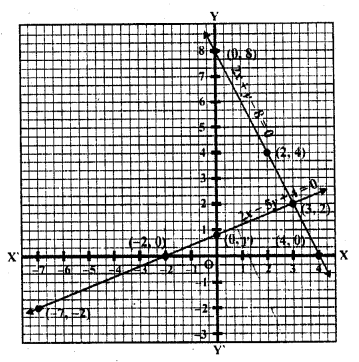
(ii) 3x + 2y = 12, 5x – 2y = 4
3x + 2y = 12
=> 3x = 12 – 2y
x = \(\frac { 12 – 2y }{ 3 }\)
Substituting some different values of y, we get their corresponding values of x as shown below

Now plot the points and join them Similarly in 5x – 2y = 4
=> 5x = 4 + 2y
x = \(\frac { 4 + 2y }{ 5 }\)

Now join these points and join them
We sec that these lines intersect each other at (2, 3)
x = 2, y= 3
There lines intersect y-axis at (0, 6) and (0, 2) respectively.
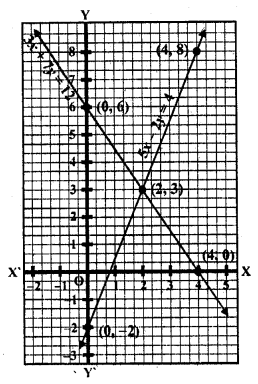
(iii) 2x + y – 11 = 0, x – y – 1 = 0
2x + y – 11 = 0 => y = 11 – 2x
Substituting some different values of x, we get their corresponding values of y as shown below:

Now plot the points and join them Similarly in x – y – 1= 0 => x = y + 1

Now plot the points and join them We see that these two lines intersect each othetr at (4, 3) and intersect y-axis at (0, 11) and (0,-1)
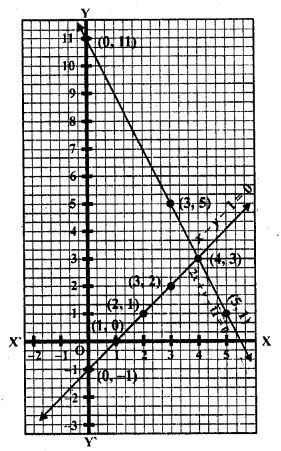
(iv) x + 2y – 7 = 0, 2x – y – 4 = 0
x + 2y – 7 = 0
x = 7 – 2y
Substituting some different value of y, we get their corresponding values of x as shown below

Now plot these points and join then Similarly in
2x – y – 4 = 0
y = 2x – 4

Now plot these points and join them We see that these two lines intersect each other at (3, 2)
and these lines intersect y-axis at (0, \(\frac { 7 }{ 2 }\)) and (0, -4)
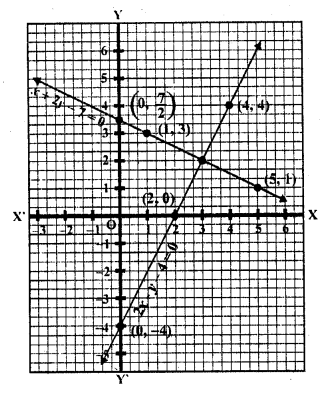
(v) 3x + y – 5 = 0, 2x – y – 5 = 0
3x + y – 5= 0
y = 5 – 3x
Substituting some different values of x, we get corresponding values of y as shown below

Now plot these points and join them Similarly in 2x – y – 5 = 6 => y = 2x – 5

Now plot these points and join them We see that these two lines intersect each other at (2, -1)
x = 2, y = 1
and these Lines intersect y-axis at (0, 5) and (0, -5) respectively.
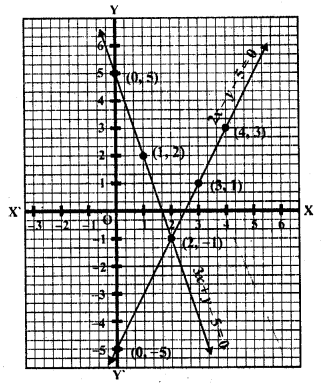
(vi) 2x – y – 5 = 0, x – y – 3 = 0
2x – y – 5 = 0
y = 2x – 5
Substituting some different values of x, we get their corresponding values of y as shown below

Plot the poinfs and join them Similarly in-the equation x – y – 3 = 0 => x =y + 3

Plot these points on the graph and join them we see that these two lines intersect each other at (2, -1)
x = 2, y = 1
and these lines intersect y-axis at (0, -5) and (0, -3)
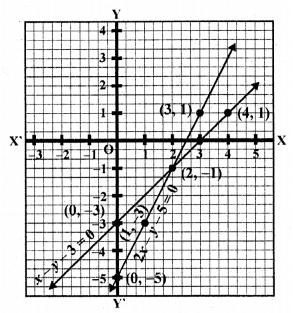
Question 23.
Solve the following system of linear equations graphically and shade the region between the two lines and x-axis
(i) 2x + 3y = 12, x – y = 1 (C.B.S.E. 2001)
(ii) 3x + 2y – 4 = 0, 2x – 3y – 7 = 0 (C.B.S.E. 2006C)
(iii) 3x + 2y – 11 = 0, 2x – 3y + 10 = 0 (C.B.S.E. 2006C)
Solution:
(i) 2x + 3y = 12, x – y = 1
2x + 3y = 12 => 2x = 12 – 3y
=> x = \(\frac { 12 – 3y }{ 2 }\)
Substituting some different values of y, we get corresponding values of x as shown below

Now plot the points on the graph and join them. Similarly in the equation
x – y = 1 => x = 1 + y

Now plot the points on the graph and join them
We see the two lines intersect each other at (3, 2) and intersect also x-axis at (6, 0) and 0,0)
The required region has been shaded.
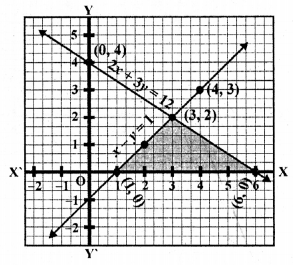
(ii) 3x + 2y – 4 = 0, 2x – 3y – 7 = 0
3x + 2y – 4 = 0
=> 3x = 4 – 2y
x = \(\frac { 4 – 2y }{ 3 }\)
Substituting some different values of y, we get corresponding values of x as shown below

Now plot the points on the graph and join them. Similarly in the equation
2x – 3y – 7 = 0
=> 2x = 3y + 7
=> x = \(\frac { 3y + 7 }{ 2 }\)

Plot these points and join them
The required region surrounded by these two lines and x-axis has been shaded as shown.
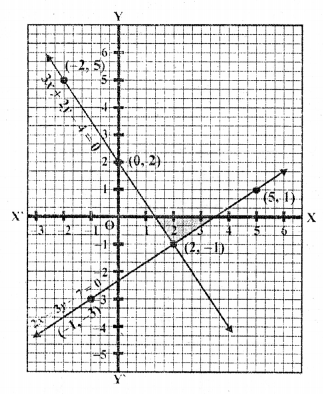
(iii) 3x + 2y – 11 = 0, 2x – 3y + 10 = 0
3x + 2y – 11
=> 3x = 11 – 2y
=> x = \(\frac { 11 – 2y }{ 3 }\)
Substituting some different value of y, we get corresponding values of x as shown below

Now plot the points and join them. Similarly in the equation
2x – 3y + 10 = 0
2x = 3y – 10
x = \(\frac { 3y – 10 }{ 2 }\)

Now plot the points and join them
The required region surrounded by these two lines and Y-axis has been shaded as shown.
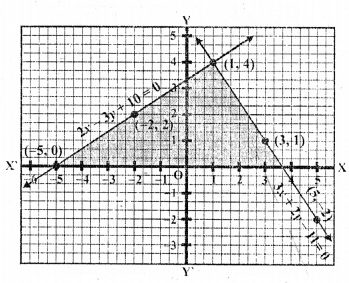
Question 24.
Draw the graphs of the following equations on the same graph paper :
2x + 3y =12
x – y = 1
Find the co-ordinates of the vertices of the triangle formed by the two straight lines and the y-axis. (C.B.S.E. 2001)
Solution:
2x + 3y = 12
⇒ 2x = 12 – 3y
x = \(\frac { 12 – 3y }{ 2 }\)
Substituting some different values of y, we get corresponding values of x as shown below

Now plot the points on the graph and join them. Similarly in the equation
x – y = 1 => x = y + 1

Now plot the points on the graph and join them
The required region surrounded by these two lines and y-axis has been shaded as shown
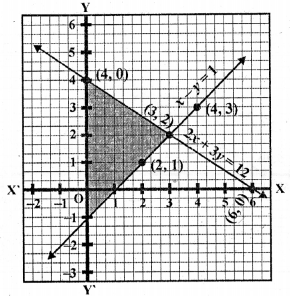
Question 25.
Draw the graphs of x – y + 1 = 0 and 3x + 2y – 12 = 0. Determine the coordinates of the vertices of the triangle formed by these lines and x-axis and shade the triangular area. Calculate the area bounded by these lines and x-axis. (C.B.S.E. 2002)
Solution:
x – y + 1 =0, 3x + 2y-12 = 0
x – y + 1 = 0
x = y – 1
Substituting some different values of y, we get so their corresponding values of x as shown below :

Now plot the points and join them Similarly, in the equation
3x + 2y – 12 = 0 => 3x = 12 – 2y
x = \(\frac { 12 – 2y }{ 3 }\)

Plot the points on the graph and join them. These two lines intersect each other at (2, 3) and x-axis at (-1, 0) and (4, 0)
Area of the triangle ABC = \(\frac { 1 }{ 2 }\) x Base x Altitude
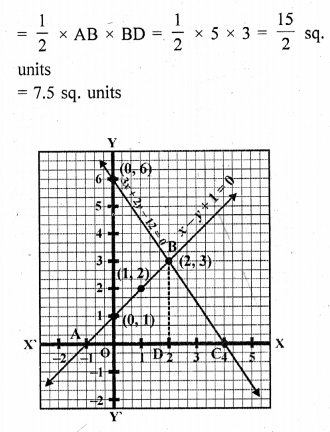
Question 26.
Solve graphically the system of linear equations :
4x – 3y + 4 = 0
4x + 3y – 20 = 0
Find the area bounded by these lines and x-axis. (C.B.S.E. 2002)
Solution:
4x – 3y + 4 = 0
=> 4x = 3y – 4
=> x = \(\frac { 3y – 4 }{ 4 }\)
Substituting some different values of y, we get their corresponding values of x as shown below:
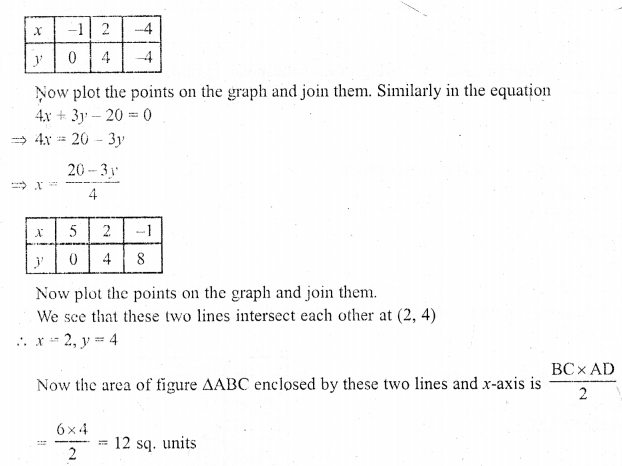
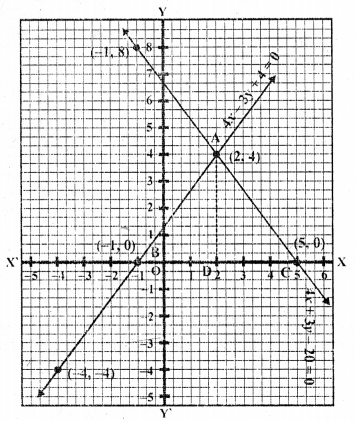
Question 27.
Solve the following system of linear equations graphically 3x + y – 11 = 0, x – y – 1 = 0. Shade the region bounded by these lines and y-axis. Also find the area of the region bounded by the these lines and y-axis. (C.B.S.E. 2002C)
Solution:
3x + y – 11=0
y = 11 – 3x
Substituting some different values of x, we get their corresponding values of y as shown below :

Now plot these points on the graph and join them Similarly in equation
x – y – 1 = 0
=> x = y + 1

Now plot these points on the graph and join them. We see that these two lines intersect each other at the point (3,2)
x = 3, y = 2
Now shade the region enclosed by these two lines and y-axis

Area of shaded ∆ABC
= \(\frac { 1 }{ 2 }\) x AC x BD
= \(\frac { 1 }{ 2 }\) x 12 x 3 = 18 sq. units
Question 28.
Solve graphically each of the following systems of linear equations. Also find the co-ordinates of the points where the lines meet the axis of x in each system.
(i) 2x + y = 6
x – 2y = -2 (C.B.S.E. 1998)
(ii) 2x – y = 2
4x – y = 8 (C.B.S.E. 1998)
(iii) x + 2y = 5
2x – 3y = -4 (C.B.S.E. 2005)
(iv) 2x + 3y = 8
x – 2y = -3 (C.B.S.E. 2005)
Solution:
(i) 2x + y = 6, x – 2y = -2
2x + y = 6
y = 6 – 2x
Substituting some different values of x, we get their corresponding values of y as shown below

Now plot the points and join them Similarly in the equation
x – 2y = -2
=> x = 2y – 2

Now plot the points and join them We see that these two lines intersect each other at (2, 2)
x = 2, y = 2
Here two lines also meet x-axis at (3, 0) and (-2, 0) respectively as shown in the figure.
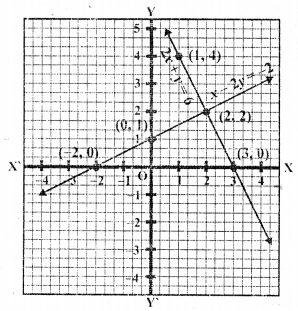
(ii) 2x – y = 2, 4x – y = 8
2x – y = 2
=> y = 2x – 2
Substituting some different values of x, we get corresponding values of y as shown below:

Now plot the points on the graph and join them Similarly in equation
4x – y = 8
=> y = 4x – 8

Now plot these points and join them We see that these two lines intersect each other at (3, 4)
x = 3, y = 4
These two lines also meet x-axis at (1, 0) and (2,0) respectively as shown in the figure
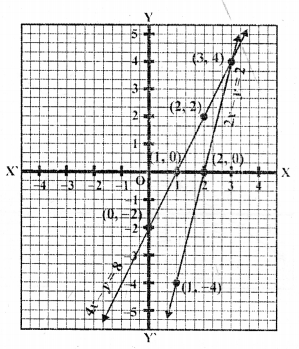
(iii) x + 2y = 5, 2x – 3y = -4
x + 2y = 5
=> x = 5 – 2y
Substituting some different values of y, we get their corresponding values of x as shown below

Now plot the points on the graph and join them
Similarly in the equation
2x – 3y = 4
=> 2x = 3y – 4
x = \(\frac { 3y – 4 }{ 2 }\)

Plot these points and join them
We see that these two lines intersect each other at (1, 2)
x = 1, y = 2
and these two lines meet x-axis at (5, 0) and (-2, 0) respectively as shown in the figure
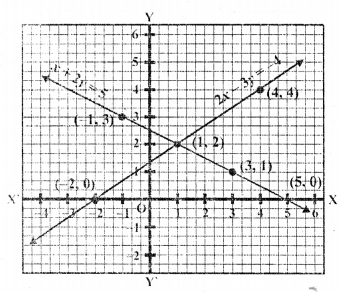
(iv) 2x + 3y = 8, x – 2y = -3
2x + 3y = 8
=> 2x = 8 – 3y
x = \(\frac { 8 – 3y }{ 2 }\)
Substituting some different values of y, we get their corresponding values of x as shown below:

Plot these points on the graph and join them Similarly in equation
x – 2y = -3
x = 2y – 3

Now plot these points and join them We see that these two lines intersect each other at (1, 2)
x = 1, y = 2
and also these lines meet x-axis at (4, 0) and (-3, 0) respectively as shown in the figure
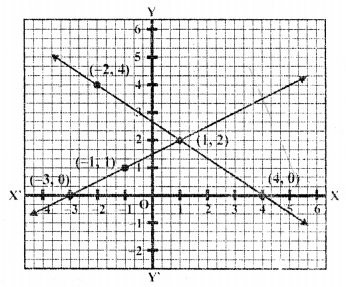
Question 29.
Draw the graphs of the following equations 2x – 3y + 6 = 0
2x + 3y – 18 = 0
y – 2 = 0
Find the vertices of the triangle so obtained. Also, find the area of the triangle.
Solution:
2x – 3y + 6 = 0
2x = 3y – 6
x = \(\frac { 3y – 6 }{ 2 }\)
Substituting some different values of y, we get their corresponding values of x as shown below:

Now plot these points on the graph and join them
Similarly in the equation 2x + 3y -18 = 0
=> 2x = 18 – 3y
x = \(\frac { 18 – 3y }{ 2 }\)

and in equation y – 2 = 0
y = 2
Which is parallel to x-axis on its positive side Now plot the points and join them We see that these lines intersect each other at (3, 4), (6, 2) and (0, 2)
Area of the triangle ABC, so formed
= \(\frac { 1 }{ 2 }\) x base x altitude
= \(\frac { 1 }{ 2 }\) x BC x AD
= \(\frac { 1 }{ 2 }\) x 6 x 2
= 6 sq. units
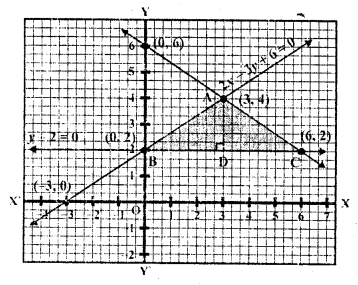
Question 30.
Solve the following system of equations graphically:
2x – 3y + 6 = 0
2x + 3y – 18 = 0
Also find the area of the region bounded by these two lines and y-axis.
Solution:
2x – 3y + 6 = 0
2x = 3y – 6
x = \(\frac { 3y – 6 }{ 2 }\)
Substituting some different values of y, we get their corresponding values of x as shown below:

Plot these points on the graph and join them Similarly in the equation
2x + 3y – 18 = 0
=> 2x = 18 – 3y
x = \(\frac { 18 – 3y }{ 2 }\)

Plot these points on the graph and join them. We see that these two lines intersect each other at (3, 4)
x = 3, y = 4
These lines formed a triangle ABC with the y-axis
Area of ∆ABC = \(\frac { 1 }{ 2 }\) x base x altitude
= \(\frac { 1 }{ 2 }\) x BC x AD
= \(\frac { 1 }{ 2 }\) x 4 x 3 = 6 Sq. units
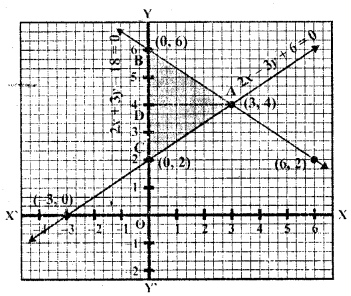
Question 31.
Solve the following system of linear equations graphically :
4x – 5y – 20 = 0
3x + 5y – 15 = 0
Determine the vertices of the triangle formed by the lines representing the above equation and the y-axis. (C.B.S.E. 2004)
Solution:
4x – 5y – 20 = 0
=> 4x = 5y + 20
x = \(\frac { 5y + 20 }{ 2 }\)
Substituting some different values of y, we get their corresponding values of x as shown below

Plot these points on the graph and join them Similarly in the equation
3x + 5y – 15 = 0
=> 3x = 15 – 5y
x = \(\frac { 15 – 5y }{ 2 }\)

Now plot these points and join them We see that these two lines intersect each other at (5, 0)
x = 5, y = 0
These two lines form a ∆ABC with y-axis whose vertices are A (5, 0), B (0, 3), C (0, -4)
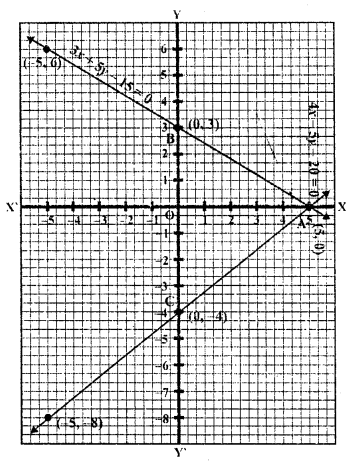
Question 32.
Draw the graphs of the equations 5x – y = 5 and 3x – y = 3. Determine the co-ordinates of the vertices of the triangle formed by these lines and y-axis calculate the area of the triangle so formed.
Solution:
5x – y = 5
=> y = 5x – 5
Substituting some different values of x, we get their corresponding values of y as shown below:

Plot these points on the graph and join them. Similarly in the equation
3x – y = 3
=> y = 3x – 3

Now plot these points and join them We see that these two lines intersect each other at (1, 0)
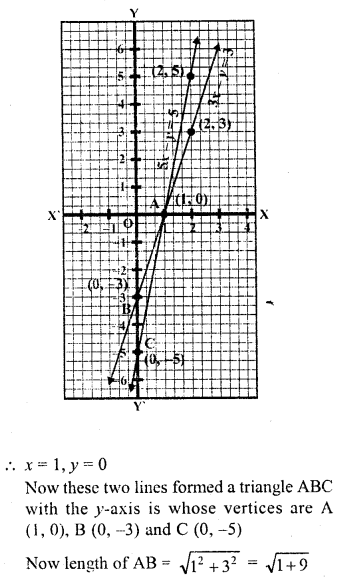
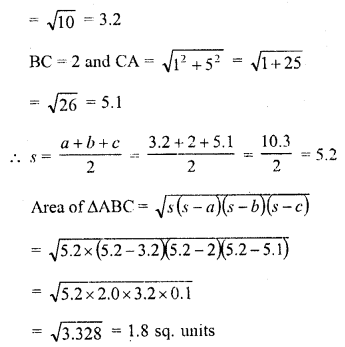
Question 33.
Form the pair of linear equations in the following problems, and find their solution graphically.
(i) 10 students of class X took part in Mathematics quiz. If the number of girls is 4 more than the number of boys, find the number of boys and girls who took part in the quiz.
(ii) 5 pencils and 7 pens together costs Rs. 50, whereas 7 pencils and 5 pens together cost Rs. 46. Find the cost of one pencil and a pen.
(iii) Champa went to a ‘sale’ to purchase some pants and skirts. When her friends asked her how many of each she had bought, she answered, “The number of skirts is two less than twice the number of pants purchased. Also the number of skirts is four less than four times the number of pants purchased.” Help her friends to find how many pants and skirts Champa bought. [NCERT]
Solution:
Let number of boys = x
and number of girls = y
According to the given conditions
x + y = 10
y – x = 4
Now, x + y = 10
=> x = 10 – y
Substituting some different values of y, we get their corresponding values of x as given below

Plot the points on the graph and join them Similarly in the equation
y – x = 4
=> y = 4 + x

Now plot the points and join them we see that these two lines intersect each other at (3, 7)
x = 3, y = 7
Number of boys = 3
and number of girls = 7
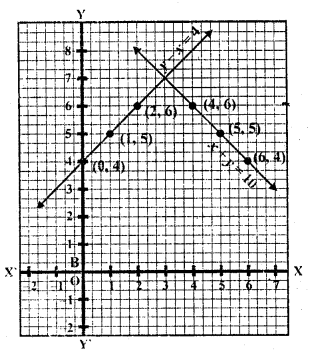
(ii) Let cost of 1 pencil = Rs. x
and cost of 1 pen = Rs. y
According to the given conditions,
5x + 7y = 50
2x + 5y = 46
5x + 7y = 50
5x = 50 – 7y
x = \(\frac { 50 – 7y }{ 5 }\)
Substituting some different values of y, we get them corresponding values of x as given below

Plot these points and join them Similarly in the equation
7x + 5y = 46
=> 7x = 46 – 5y
=> x = \(\frac { 46 – 5y }{ 7 }\)

Now plot the points on the graph and join them. We see that these two lines intersect each other at (3, 5)
x = 3, y = 5
or cost of pencil = Rs. 3
and cost of a pen = Rs. 5
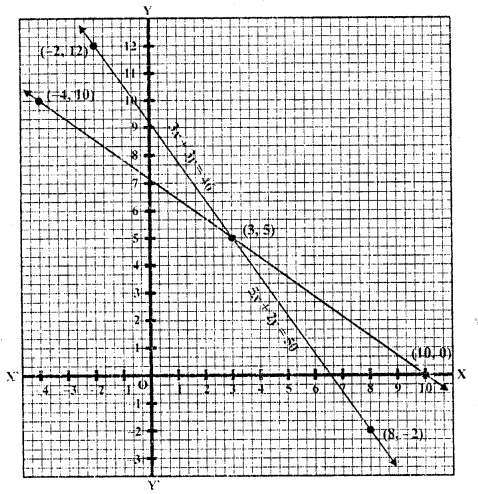
(iii) Let number of skirts = x
and number of pants = y
According to the given condition,
x = 2y – 2 and x = 4y – 4
2y – 2 = 4y – 4
4y – 2y = -2 + 4
2y = 2
y = 1
and x = 2y – 2 = 2 x 1 – 2 = 2 – 2 = 0
Number of skirts = 0
and number of pants = 1
Question 34.
Solve the following system of equations graphically shade the region between the lines and the y -axis
(i) 3x – 4y = 7
5x + 2y = 3 (C.B.S.E. 2006C)
(ii) 4x – y = 4
3x + 2y = 14 (C.B.S.E. 2006C)
Solution:
(i) 3x – 4y = 7
3x = 7 + 4y
x = \(\frac { 7 + 4y }{ 3 }\)
Substituting some different values of y, we get their corresponding values of x as shown below

Plot these points on the graph and join them. Similarly in the equation
5x + 2y = 3
=> 5x = 3 – 2y
x = \(\frac { 3 – 2y }{ 5 }\)

Plot these points and join them We see that the lines intersect each other at (1, -1)
x = 1, y = -1
Now the region between the these lines and y-axis has been shaded as shown
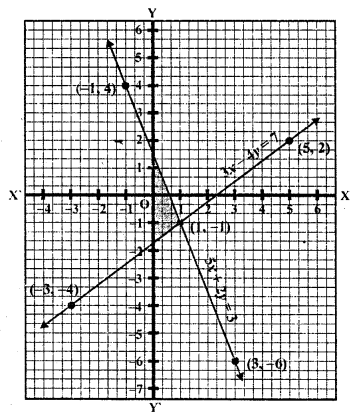
(ii) 4x – y = 4
3x + 2y = 14
4x – y = 4
y = 4x – 4
Substituting some different values of x, we get their corresponding values of y as given below

Plot these points and join them Similarly in equation
3x + 2y = 14
3x = 14 – 2y
x = \(\frac { 14 – 2y }{ 3 }\)

Now plot these points and join them
We see that these lines intersect each other at (2, 4)
x = 2, y = 4
The region between these two lines and y-axis has been shaded as shown
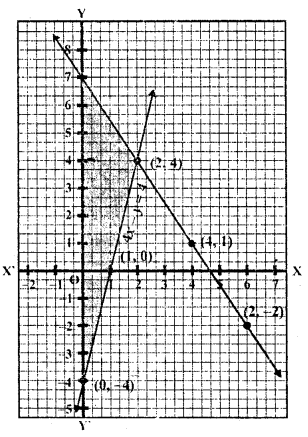
Question 35.
Represent the following pair of equations graphically and write the coordinates of points where the lines intersects y-axis
x + 3y = 6
2x – 3y = 12 (C.B.S.E. 2008)
Solution:
x + 3y = 6
x = 6 – 3y
Substituting some different values of y, we get their corresponding values of x as shown below

Now plot these points on the graph and join them
Similarly in the equation
2x – 3y = 12 => 2x = 12 + 3y
x = \(\frac { 12 + 3y }{ 2 }\)

Now plot there points and join them We see that these two lines meet y-axis at (0, 2) and (0, -4)
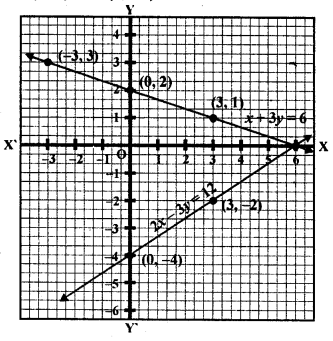
Question 36.
Given the linear equation 2x + 3y – 8 = 0, write another linear equation in two variables such that the geometrical representation of the pair so formed is
(i) intersecting lines
(ii) Parallel lines
(iii) coincident lines [NCERT]
Solution:
Given a linear equation 2x + 3y – 8 = 0
(i) When the lines are intersecting, then
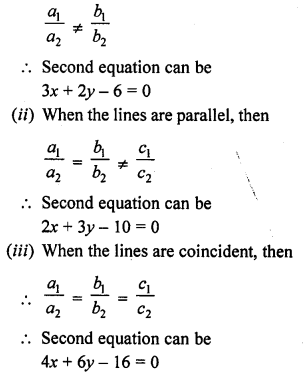
Question 37.
Determine graphically the co-ordinates of the vertices of a triangle, the equations of whose sides are :
(i) y = x, y = 2x and y + x = 6 (C.B.S.E. 2000)
(ii) y = x, 3y = x, x + y = 8 (C.B.S.E. 2000)
Solution:
(i) y = x
Substituting some different values of x, we get their corresponding values of y as shown below

Now plot the points on the graph and join them. Similarly in the equation y = 2x

and y + x = 6 => x = 6 – y

Now plot the points on the graph and join them. We see that these lines intersect each other at (0, 0), (3, 3) and (2, 4)
Vertices of the triangle so formed by these lines are (0, 0), (3, 3) and (2, 4)
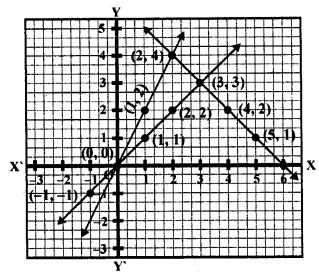
(ii) y = x, 3y = x, x + y = 8
y = x
Substituting some different values of x, we get corresponding values of y as shown below

Plot these points on the graph and join them Similarly in the equation 3y = x

and x + y = 8 => x = 8 – y

Now plot the points and join them. We see that these lines intersect each other at (0,0), (4, 4), (6, 2)
The vertices of the triangle so formed are (0, 0), (4, 4) and (6, 2)
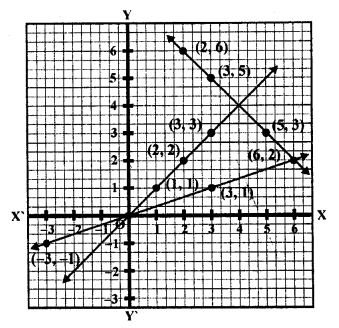
Question 38.
Graphically, solve the following pair of equations:
2x + y = 6
2x – y + 2 = 0
Find the ratio of the areas of the two triangles formed by the lines representing these equations with the x-axis and the lines with the y-axis. [NCERT Exemplar]
Solution:
Given equations are 2x + y – 6 and 2x – y + 2 = 0
Table for equation 2x + y = 6
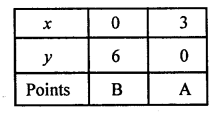
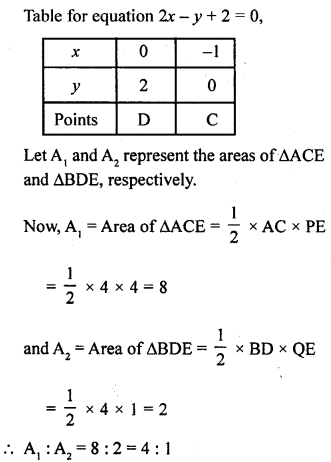
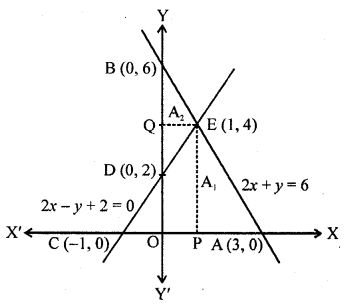
Hence, the pair of equations intersect graphically at point E (1, 4), i.e., x = 1 and y = 4
Question 39.
Determine, graphically, the vertices of the triangles formed by the lines y = x, 3y = x, x + y = 8. [NCERT Exemplar]
Solution:
Given linear equations are y = x …….(i)
3y = x ………(ii)
and x + y = 8 …….(iii)
For equation y = x,
If x = 1, then y = 1
If x = 0, then y = 0
If x = 2, then y = 2
Table for line y = x,
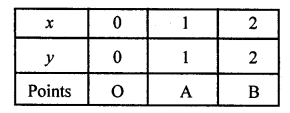
For equation x = 3y
If x = 0, then y = 0,
if x = 3, then y = 1
and if x = 6, then y = 2
Table for line x = 3y,
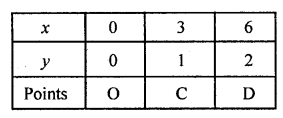
For equation,
If x = 0, then y = 8
if x = 8, then y = 0
and if x = 4, then y = 4
Table for line x + y = 8,
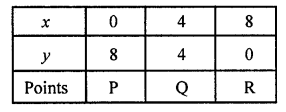
Plotting the points A (1, 1) and B (2,2), we get the straight line AB. Plotting the points C (3, 1) and D (6, 2), we get the straight line CD. Plotting the points P (0, 8), Q (4, 4) and R (8, 0), we get the straight line PQR. We see that lines AB and CD intersecting the line PR on Q and D, respectively.
So, ∆OQD is formed by these lines. Hence, the vertices of the ∆OQD formed by the given lines are O (0, 0), Q (4, 4) and D (6, 2).
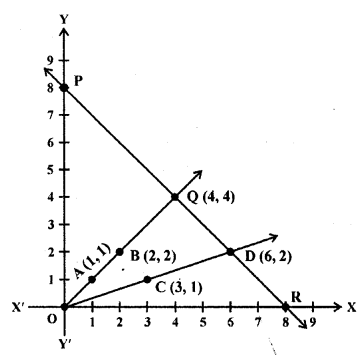
Question 40.
Draw the graph of the equations x = 3, x = 5 and 2x – y – 4 = 0. Also, find the area of the quadrilateral formed by the lines and the x-axis. |NCERT Exemplar]
Solution:
Given equation of lines 2x – y – 4 = 0, x = 3 and x = 5
Table for line 2x – y – 4 = 0,
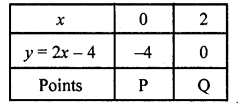
Draw the points P (0, -4) and Q (2,0) and join these points and form a line PQ also draw the lines x = 3 and x = 5.
Area of quadrilateral ABCD = \(\frac { 1 }{ 2 }\) x distance between parallel lines (AB) x (AD + BC) [since, quadrilateral ABCD is a trapezium]
= \(\frac { 1 }{ 2 }\) x 2 x (6 + 2) [∵ AB = OB – OA = 5 – 3 = 2, AD = 2 and BC = 6]
= 8 sq. units
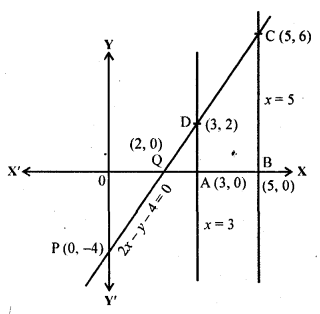
Hence, the required area of the quadrilateral formed by the lines and the x-axis is 8 sq. units.
Question 41.
Draw the graphs of the lines x = -2, and y = 3. Write the vertices of the figure formed by these lines, the x-axis and the y-axis. Also, find the area of the figure. [NCERT Exemplar]
Solution:
We know that the graph of x = -2 is a line parallel to y-axis at a distance of 2 units to the left of it. So, the line l is the graph of x = -2
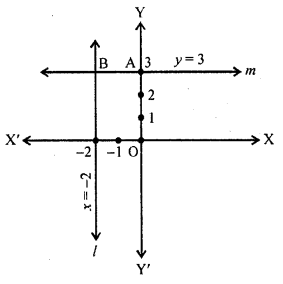
The graph of y = 3 is a line parallel to the x-axis at a distance of 3 units above it.
So, the line m is the graph of y = 3
The figure enclosed by the line x = -2, y = 3, the x-axis and the y-axis is OABC, which is a rectangle.
A is a point on the y-axis at a distance of 3 units above the x-axis. So, the coordinates of A are (0, 3).
C is a point on the x-axis at a distance of 2 units to the left of y-axis. So, the coordinates of C are (-2, 0).
B is the solution of the pair of equations x = -2 and y = 3. So, the coordinates of B are (-2, 3).
So, the vertices of the rectangle OABC are O (0, 0), A (0, 3), B (-2, 3), C (-2, 0).
The length and breadth of this rectangle are 2 units and 3 units, respectively.
As the area of a rectangle = length x breadth, the area of rectangle OABC = 2 x 3 = 6 sq. units.
Question 42.
Draw the graphs of the pair of linear equations x – y + 2 = 0 and 4x – y – 4 = 0. Calculate the area of the triangle formed by the lines so drawn and the x-axis. [NCERT Exemplar]
Solution:
For drawing the graphs of the given equations, we find two solutions of each of the equations, which are given in table.
Plot the points A (0,2), B (-2,0), P (0, -4) and Q (1,0) on the graph paper, and join the points to form the lines AB and PQ as shown in the figure.
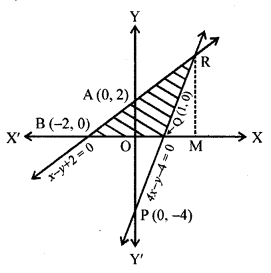
We observe that there is a point R (2,4) common to both the lines AB and PQ. The triangle formed by these lines and the x-axis is BQR.
The vertices of this triangle are B (-2, 0), Q (1, 0) and R (2, 4).
We know that;
Area of triangle = \(\frac { 1 }{ 2 }\) x Base x Altitude
Here, Base = BQ = BO + OQ = 2 + 1 = 3 units
Altitude = RM = Ordinate of R = 4 units.
So, area of ABQR = \(\frac { 1 }{ 2 }\) x 3 x 4 = 6 sq. units
Hope given RD Sharma Class 10 Solutions Chapter 3 Pair of Linear Equations in Two Variables Ex 3.2 are helpful to complete your math homework.
If you have any doubts, please comment below. Learn Insta try to provide online math tutoring for you.
